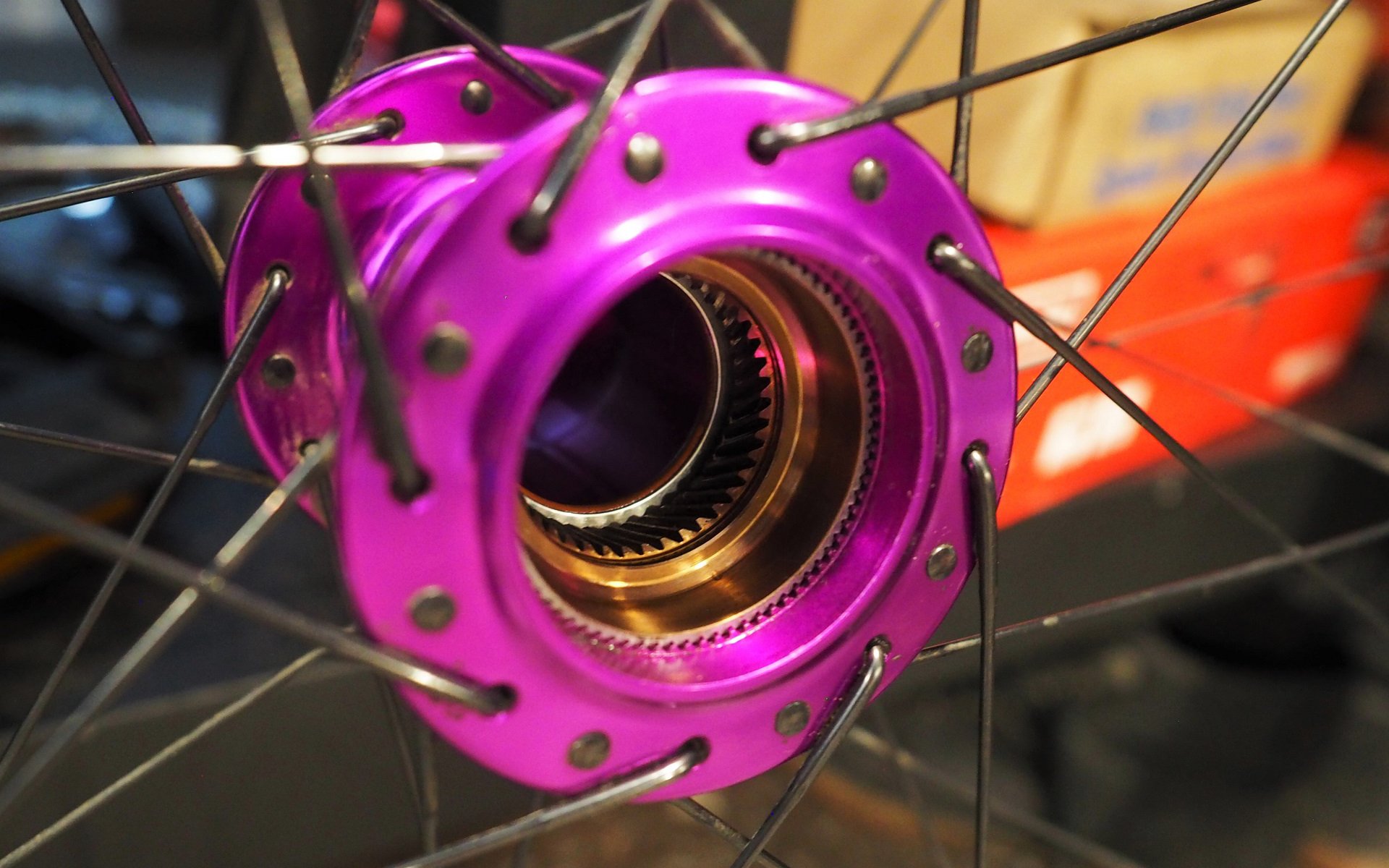
TEARDOWN
A Chris King RingDrive Hub Experience, Part II (2 Yrs Later)
Previously On NSMB
It seems like a decade has passed since I started riding this set of King hubs. In actuality, it's only been a couple of years but they are, in a way, relics of an earlier time. They use ISO 6-Bolt rotor mounting, a standard King no longer supports. They're anodized purple, a colour King doesn't currently offer. They even predate Chris King's recyclable carbon wheel program. And yet the guts are the same as they've been for over twenty years. They contain the same house-made stainless steel bearings, the same heat-treated stainless steel drive components, and use the same service tool to overhaul them.
Part 1 of this review was easy, but when should I follow up with Part 2? I've had to replace a couple bearings in my old King single speed hub - maybe that's the right time for a follow up? I never did decide on a plan and that's why it took until now to write something. After two years, and a couple of minor wipe-and-lubes, which just constitute pulling the freehub body, this Chris King hub was ready for a full overhaul, and so that's where we've landed.
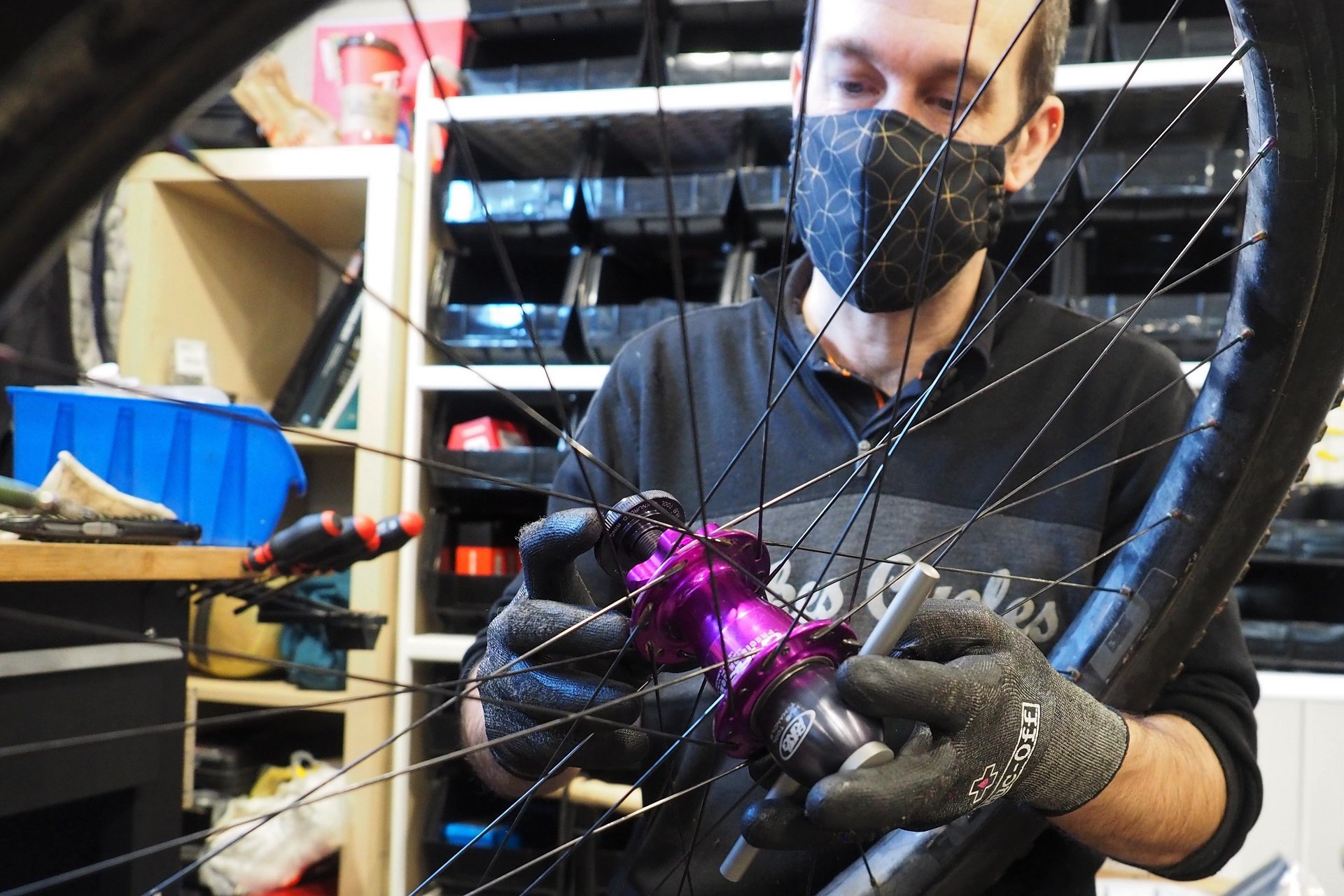
My friend Nice Guy Geoff has been a bike mechanic in Vancouver for years now. You might recognize him from a couple of different local shops, or as a past instructor for Jeff Bryson at Bikeroom. Local music nerds may also recall his days with "The Red Light Sting."
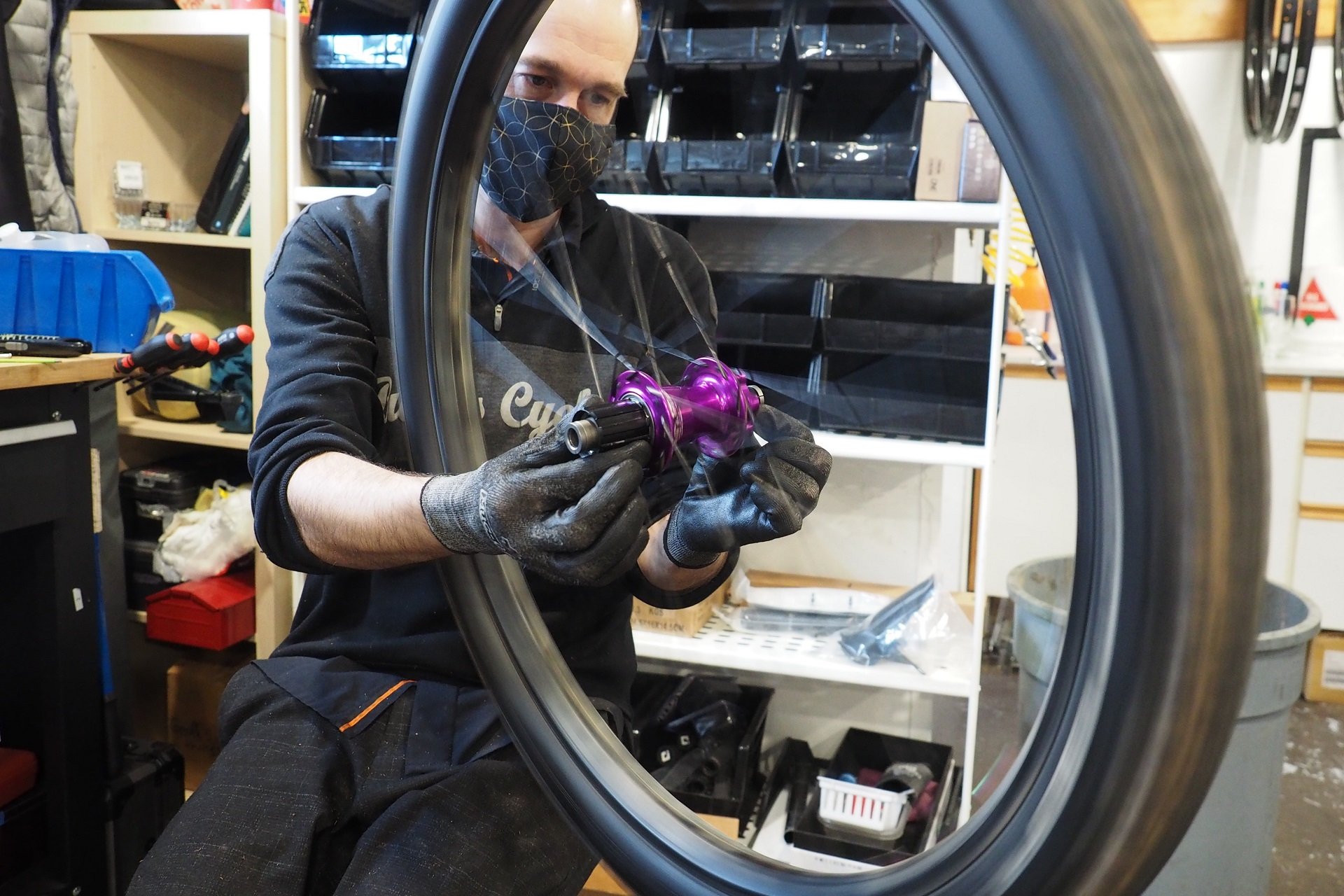
These days he's practicing his trade as a solo act, turning wrenches at my friend Jac's shop Essential Cycles. Nice Guy is helping me out with a few teardowns this year encompassing both premium and lower-cost components.
I have a lot of experience with Chris King hubs. My wife has them on her bikes, they're all my brother rides, my single speed hub is approaching two decades old, and I have a number of friends who swear by them. Some of their hubs are old enough that the 'Discotech' rotor mounts are removable. The vast majority of those hubs started life as 135mm QR hubs, then were upgraded to 142 x 12mm thru-axle hubs, and quite a few of them are now being run with Boostinator kits to fit 148 x 12mm. There are a lot of clichés about bike parts lasting forever, but in my experience, these do not have a shelf life.
Aside from updating hub axles to fit new standards, the only replacement parts I've bought are a HG freehub body (I wish they still made a stainless steel option) and a couple of hubshell bearings for my single speed hub. If you don't do the work yourself there will be a labour cost associated with maintaining the hubs and they have to be serviced by someone with access to the Chris King hub tool but the cost of some local labour, and the upfront cost of the hubs that may last forever, is a very solid value. I couldn't even guess what I paid for my hubs it was so long ago. I love that.
Housekeeping
Most folks I know prefer to have matching hubsets - make, model, colour - and Chris King makes premium quality front hubs as well, which will also last forever with a simple clean-and-grease behind the bearing seal & snap-ring once in a blue moon. I'm running a matched set of purple hubs on my bike. However, in the immortal words of my mechanic friend Craig, "a front hub is a tube with two bearings."
The min-maxing choice, without committing the ocular offense of mismatched hubs (the horror!), is to take a black or silver Chris King rear hub and match it to a budget friendly front hub with the same finish. Anodized black front hubs are easy enough to come by. On the silver front, a Spank Hex J-Type is a good option that matches up nicely and has the added bonus that the Spank branding is barely visible. They're on the short list of brands that make nice stuff and could sell a lot more of it with a branding overhaul. It turns out some folks don't want the work SPANK written loudly all over their bikes.
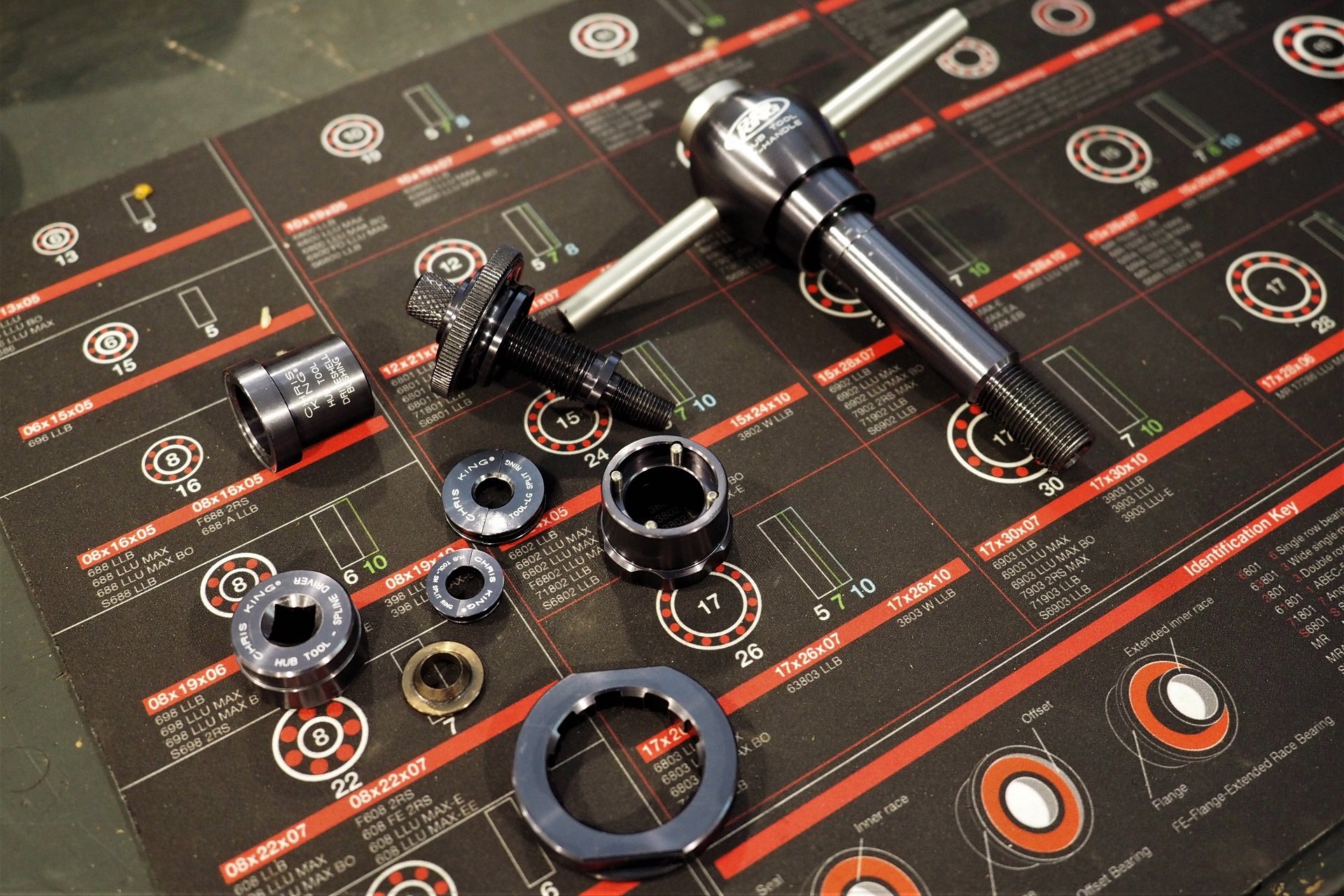
My King hub tool is closer to twenty years old than it is to today though I can't remember exactly when I bought it. I've yet to replace a single part on it, though it does occasionally take a bit of extra coaxing to get the split-rings to engage with the bearings properly than it did when the tool was new.
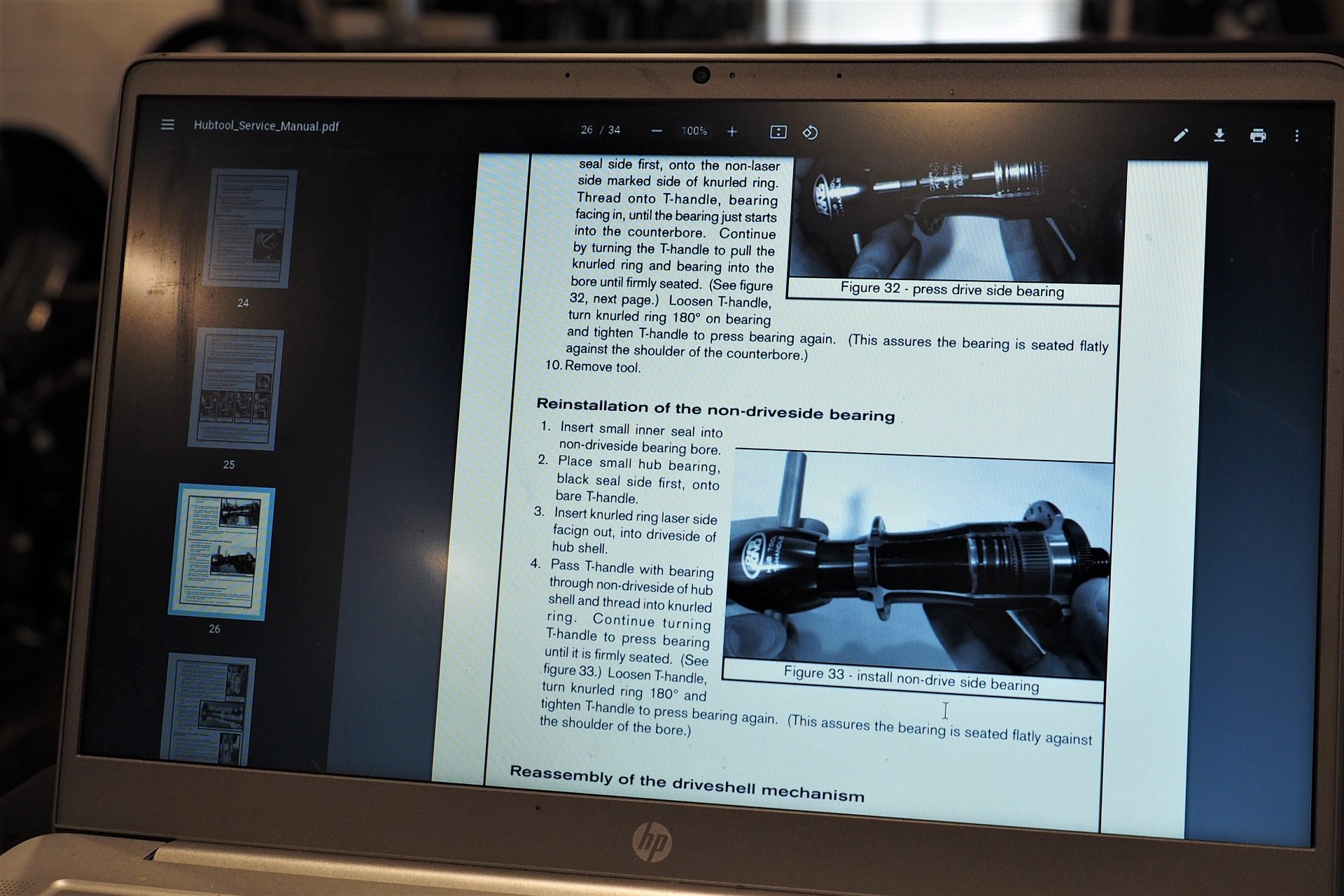
RTFM. Whether it's setting up a front derailleur, swapping an air spring, rebuilding a Chris King hub, or some other job that I'm not doing regularly, I always read the manual before taking out the tools. Chris King publishes their hub service manual, and a range of other technical information and updates on their website.
I will lament King's choice to abandon ISO 6-Bolt rotor mounting here, and then not mention it again. As a business, I respect that it's their decision to reduce their SKU count by moving to only supporting Center Lock rotor mounting. Given that Center Lock (CL) is widely preferred for road and gravel, and that most mountain bikers don't care, if they were going to choose to just support one option then it makes sense that CL would be it. It's sad for me, as I greatly prefer 6-Bolt and can't see myself ever investing my own money in a CL hub and, therefore, never buying another King hub myself.
**Updated (thanks Kachew)** Chris King's current Boost Rear Hub is slightly different than what I'm testing here. As of 2021, whether you order them with HG, XD, or MicroSpline drivers they no longer use a needle bearing in the freehub body. They're currently available in ten different colours, including a two-tone Black & Gold that is pure class.
On the good news front, perhaps more than any used bicycle part, a Chris King hub is just a rebuild away from perfection. I'd make certain it has the current solid axle and preloader setup rather than the old three-piece axles, which were prone to failure under hard use, but even buying a 135mm QR hub, in good shape, for the right price and then springing for an axle kit will deliver years of value. Worst case, the hub may need a few bearings but that's unlikely. I've yet to meet anyone who's had to replace the drive or driven rings or one of the 1-piece axles.
Teardown Two
Bikeroom-Jeff is living in Kaslo, BC these days so our mutual friend, Nice Guy Geoff, has stepped up to help me with some teardown pieces this year. Nice Guy and I share a love for the functional art at the pinnacle of premium bicycle design, like Chris King's hubs, and also for min-maxing solutions to keep folks riding. We've turned wrenches together in the heart of the pandemic parts shortage fixing 'unserviceable' parts that couldn't be replaced to the sounds of Pokey LaFarge, Tom Waits, No Doubt, The Coup, and occasionally the soundtrack to Disney's Robin Hood (1973) so I'm hoping that as we develop our process the amount of fun we have around bikes comes through in our work.
This teardown is somewhat anti-climatic. Spoiler alert and all that, but we didn't replace a single part so in some ways this is a duplication of the first teardown that I did with Jeff, just two years later and with some cleaning required. The needle and the cartridge bearing in the freehub body were filthy, the drive system was gunky, and generally performance had degraded extensively from the broken-in high point a few months after I started riding the hub. Input a bit of time, clean everything up, add some King bearing grease and Ring Drive Lube 2.0, and the hub is running smoother and faster than new.
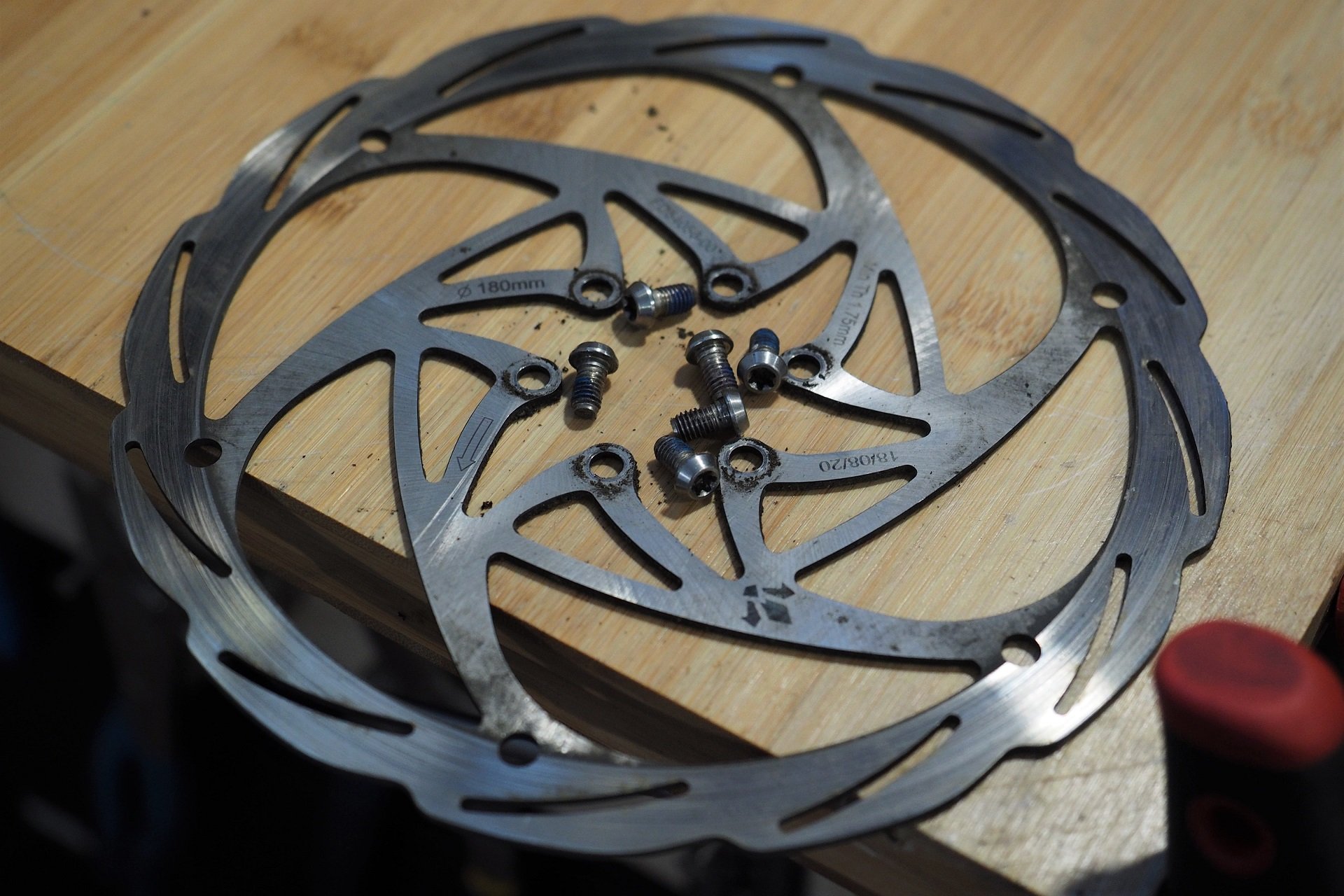
Grab a T-25 and remove those six titanium bolts. Will everything be Center Lock within a few years? Probably, sadly, yes.
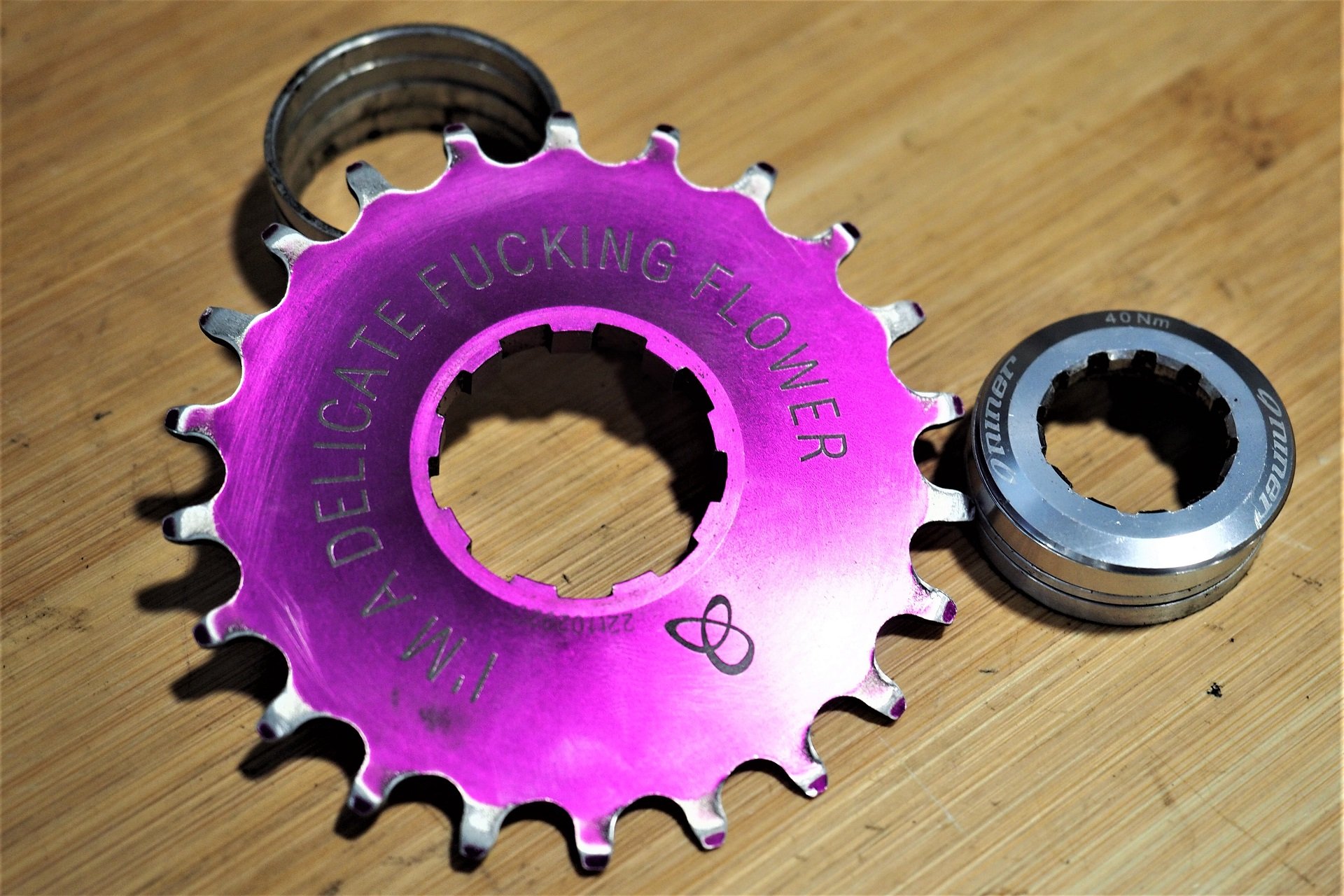
My Kick Ass Cog is starting to look a little bit beaten down. As a single speeder it always makes sense to have another one ready to go but I'll keep filing the burrs and riding this beauty until it's fully dead.
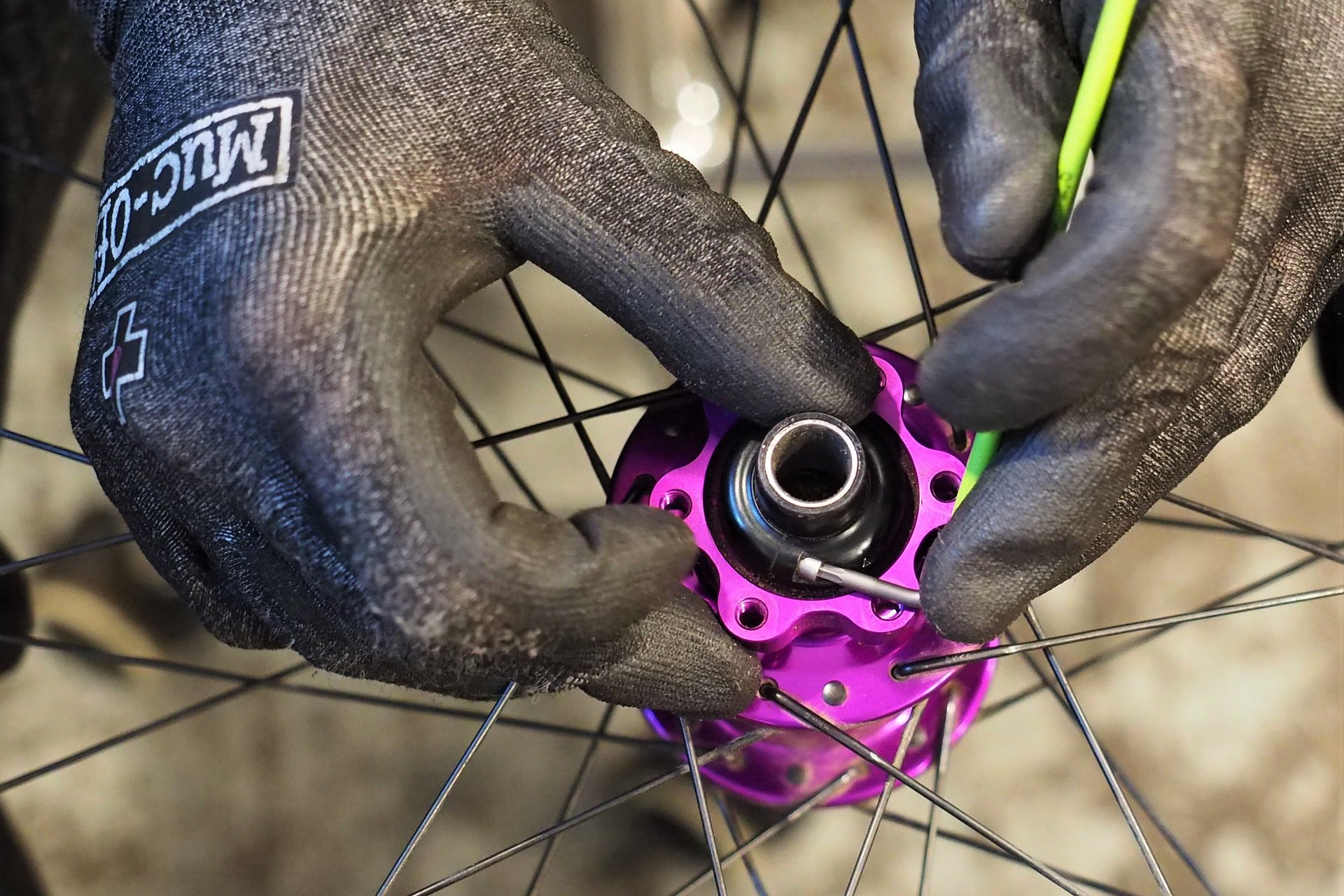
Removing the axle preload cap to open up the hub. Rather than cranking down the bearing preload when the rebuild is done, be prepared to loosen the 2.5mm hex bolt and hand tighten this preloader after the first 1-2 rides as the hub settles in.
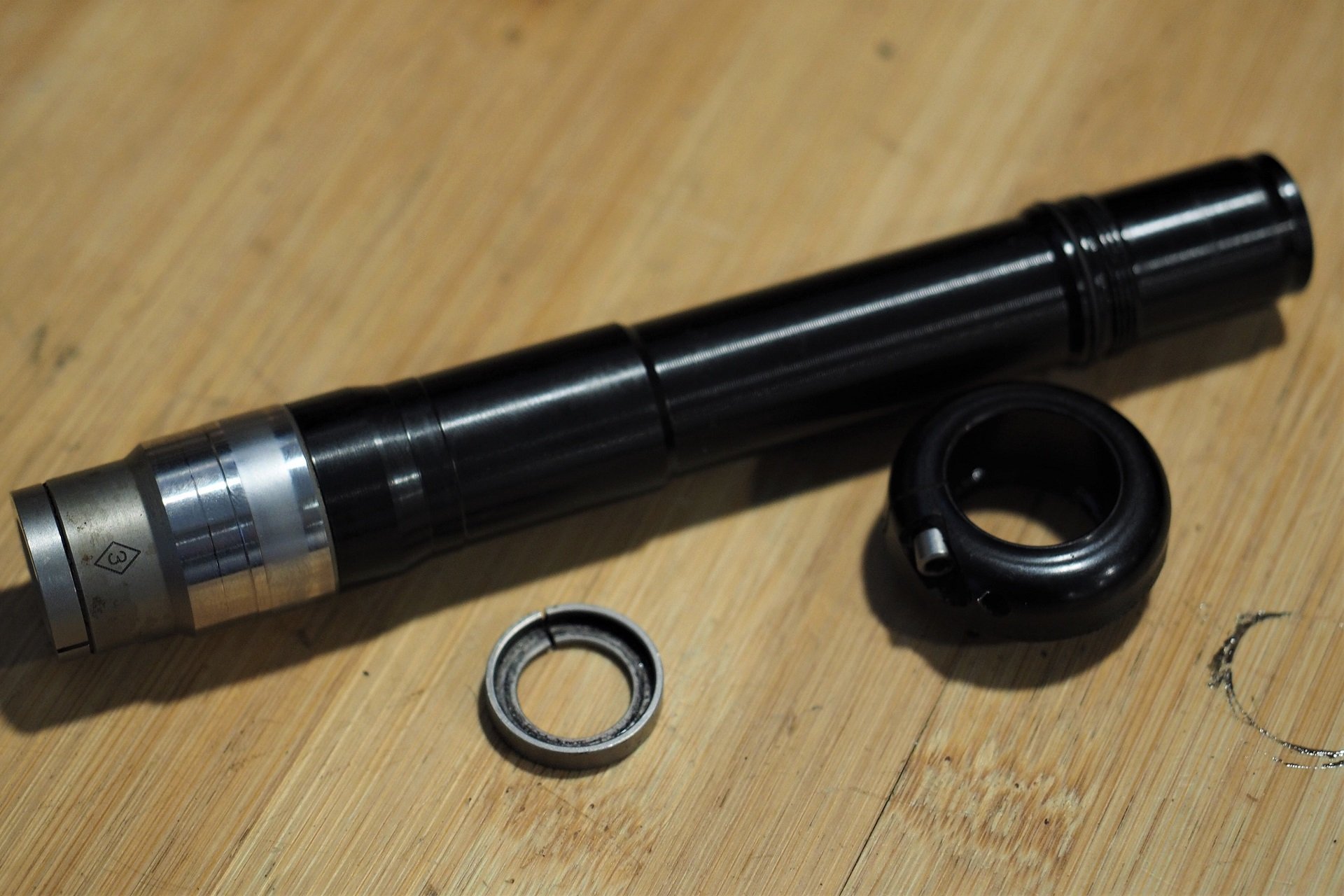
This is the first Chris King hub I've had where the aluminum parts of the axle and preloader are anodized black, rather than silver. I was pleasantly surprised to see zero wear on the axle after two-years.
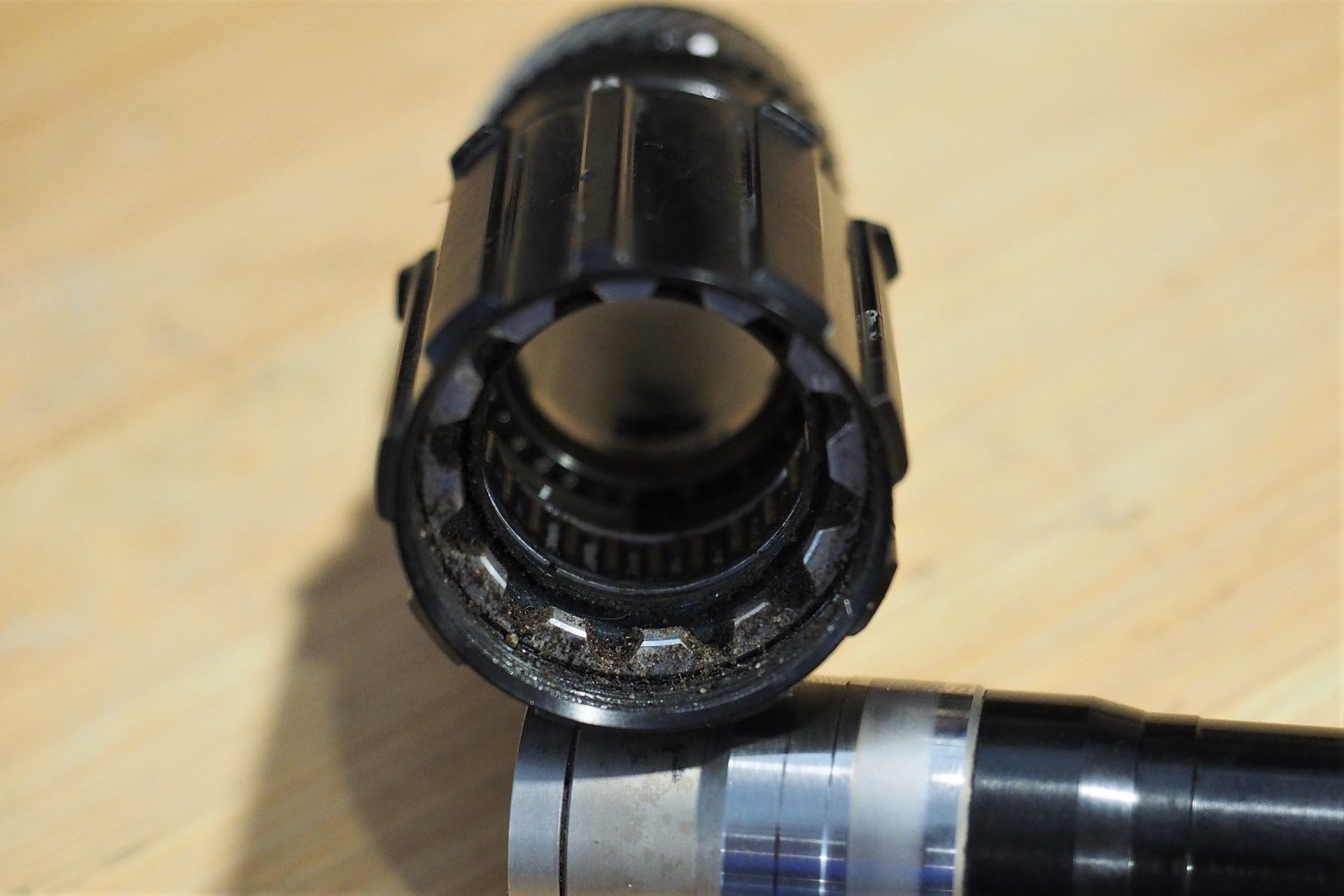
It's plenty dirty in there and the needle bearing is gunked up but a quick clean and lube is all any of the components needed.
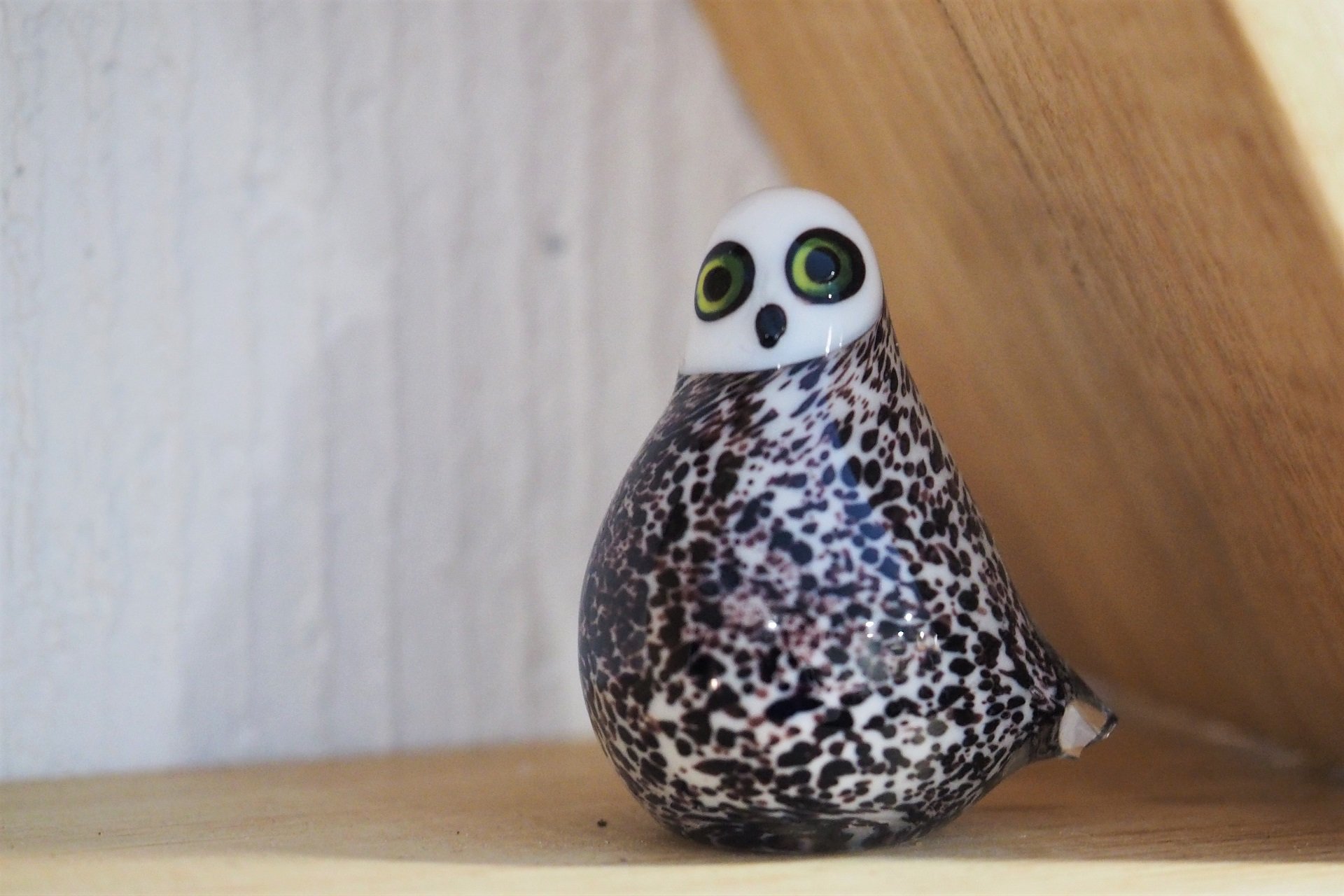
Bike shop randoms: The New Zealand Morepork owl is called that because at night it calls out "MORE-PORK, MORE-PORK, MORE-PORK!" Don't worry though, they average about 175 grams and eat bugs, birds, and small mammals, so your bacon-stash is probably safe. [Update: The MorePork is called the Rūrū in the indigenous Maori language. If you click HERE you can decide for yourself if it sounds more like "MORE PORK" or "RURU" for yourself - thanks Karl Fitzpatrick & Velocipedestrian]
If you're servicing your own King hub for the first time, I'd recommend taking your time with the tool to make certain that the bearings are fully captured before you start swinging your hammer. Your plastic or hard rubber-headed hammer, of course. In fact, if you haven't used the King hub tool, or haven't used it for a while, then I'd recommend browsing through the hub tool manual a couple times. I'd consider myself fairly decent on the tools and if I have even a moment's doubt I always RTFM. It's saved me many, many, times.
Another piece of advice, do your hammering over a receptacle of some kind, like a cardboard box. The Chris King bearings are full serviceable, and rebuildable, provided you have all the the ball bearings. But, the ball bearings are stainless steel so if a bearing comes apart during removal you can't use a magnet to pick up the small-scale spheres. Take it from someone who's crawled around a shop with other adults searching for that one missing ball bearing, after hours on a Friday night, for a bike that had been promised the next morning; before you start swinging have a good idea where stuff is going to go.
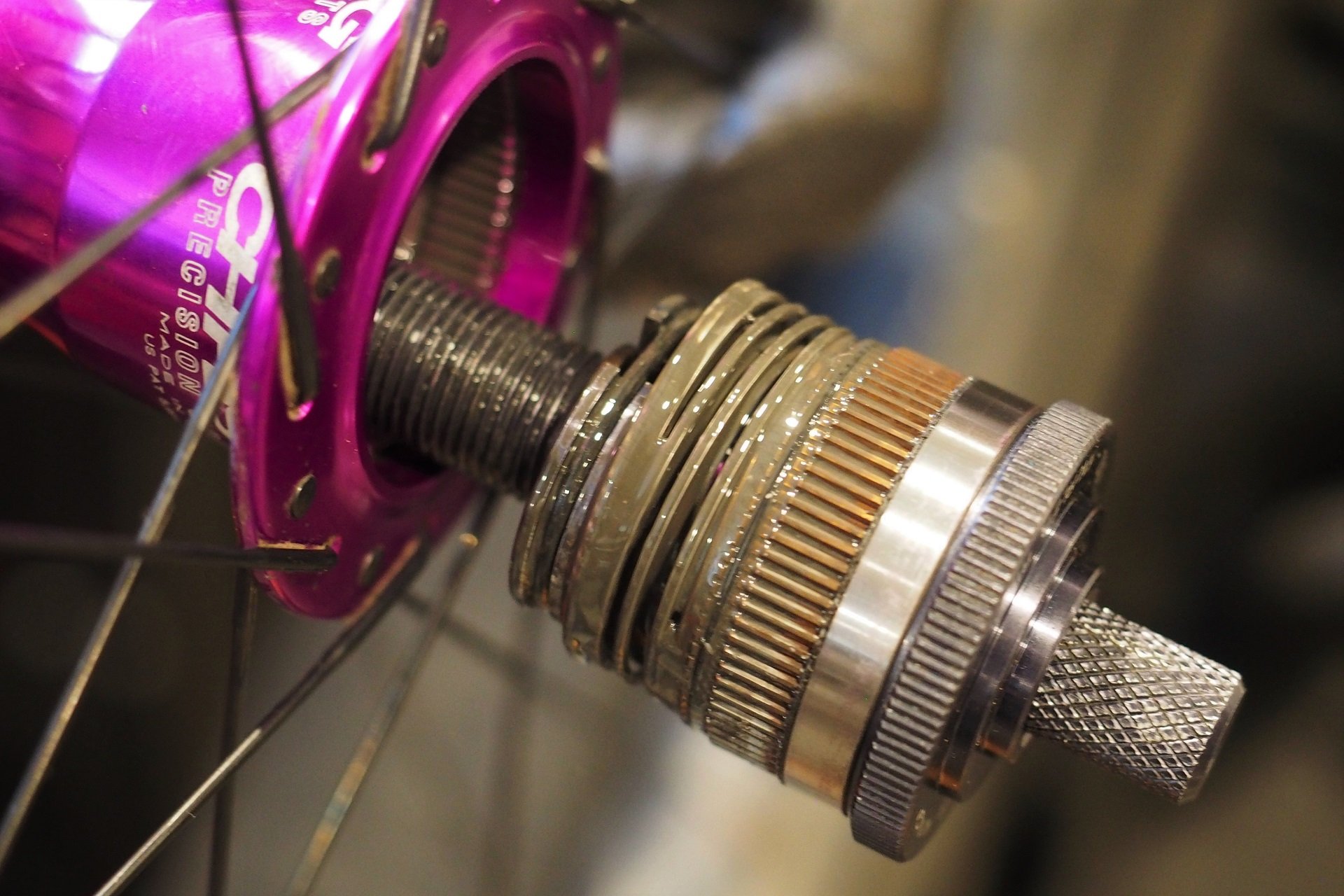
Spoiler alert, there wasn't a single component that needed to be replaced after two years.
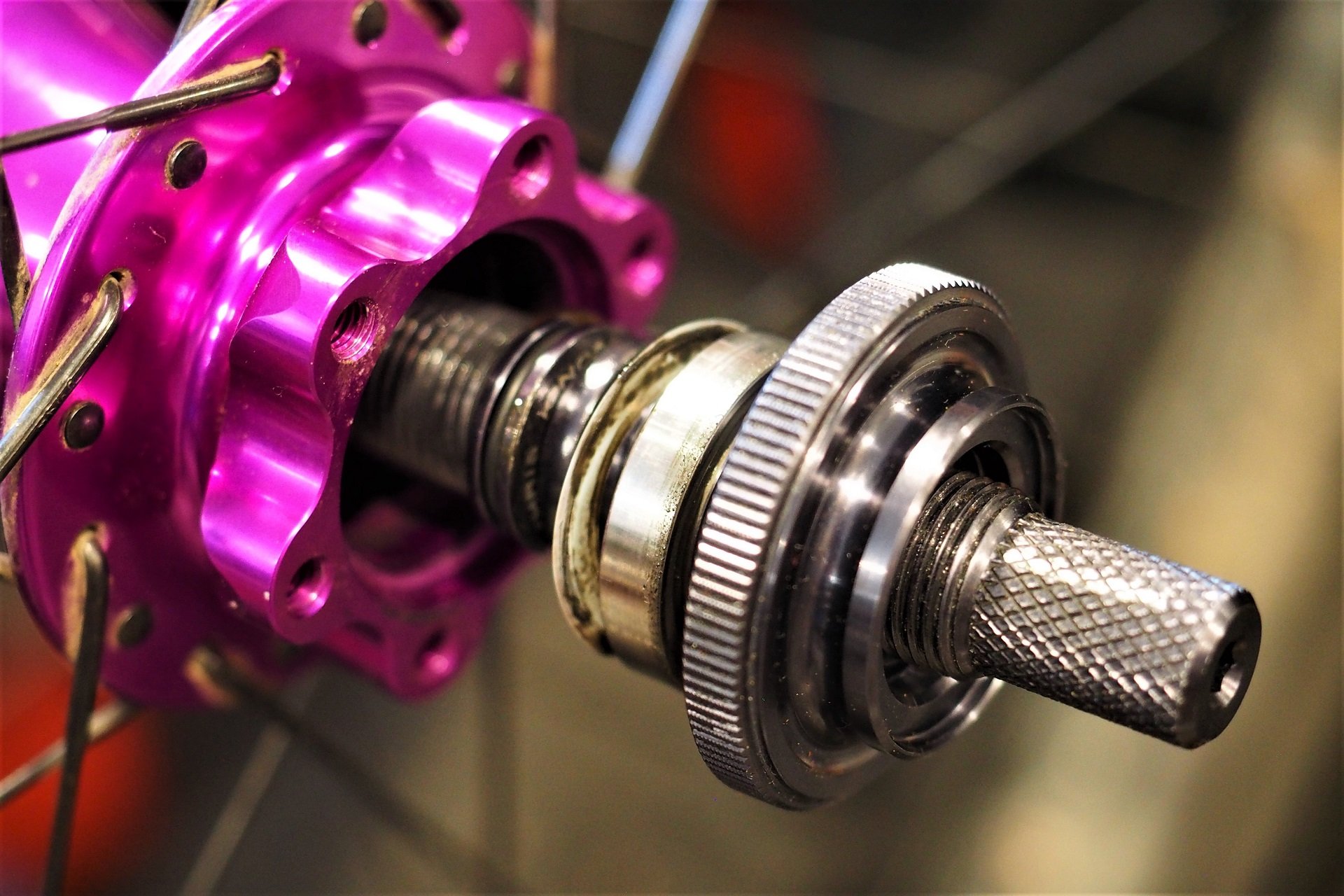
Be diligent to properly seat the tool's split-rings against the bearings before any extraction starts. This is a precision tool and deserves to be treated as such.
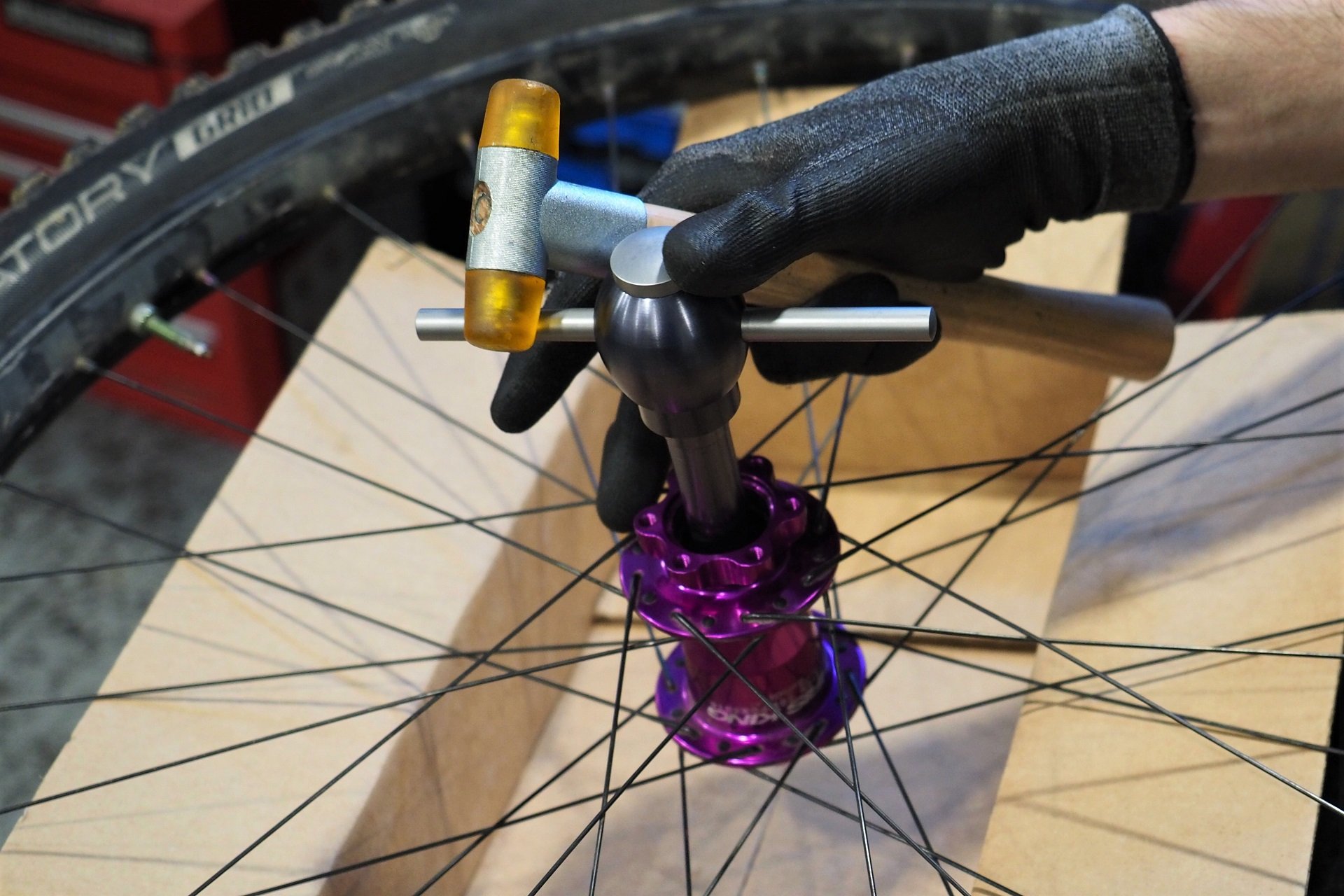
What's with the box? Chris King's bearings use stainless steel balls, which in turn means if one comes apart there's no 'just' waving a magnet around to attract all the parts to put it back together.
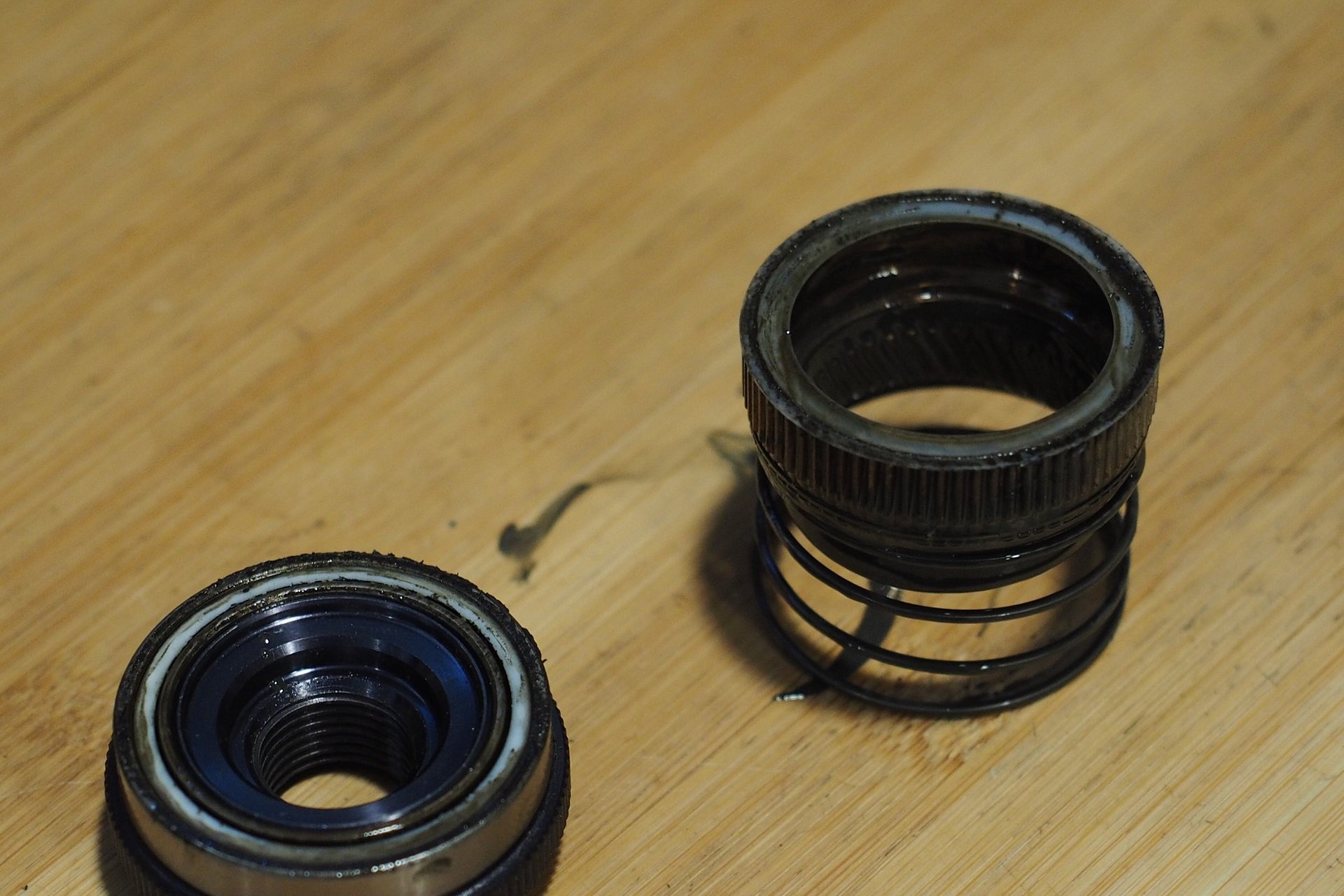
Sludgeilicious drive system. It's little wonder this hub was so sluggish and the difference in drag is night v. day.
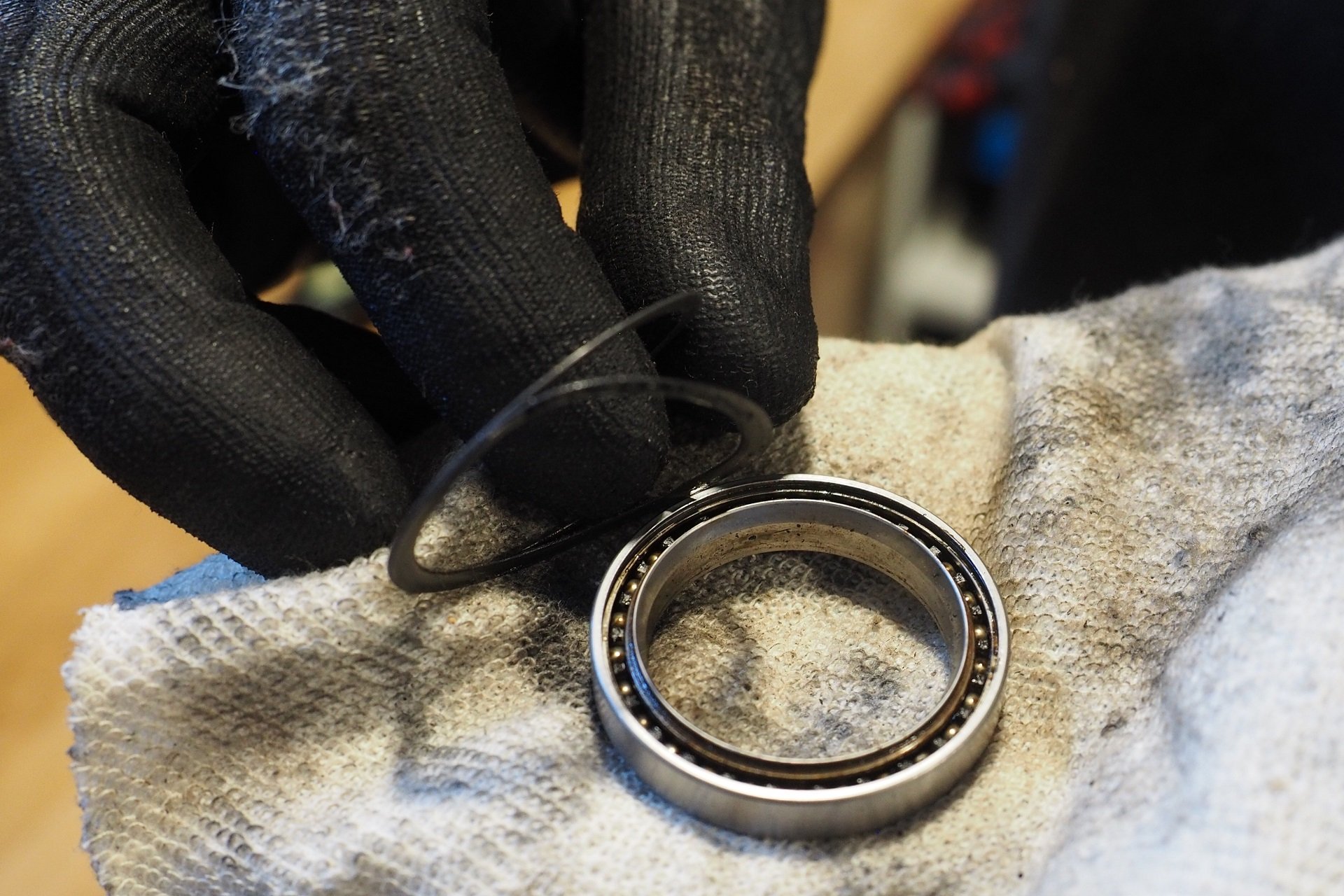
All the bearings get their seals and snap rings removed, thoroughly cleaned, and then re-greased. King does sell the seals and snap rings separately if they require replacement but if you're gentle they'll last the life of the bearing.

Is it just me or does every shop in town have an entire rack of We Are One carbon hoops ready to roll these days? Geoff still laces up a lot of wheels every year, from the Kamloops carbon company but also 26" v-brake rims to keep that old commuter running.
There are two takes on preloading hub bearings, and when it comes to premium hubs this will largely come down to your personal preference. Hubs like Chris King, Onyx Classic, and Project 321 use a preloader ring that gets locked into position on the axle by tightening a screw. This allows for optimum bearing preload adjustment and also allows for an awful range of over- or under-tightened bearing preload. Other premium hubs, like the Industry Nine Hydra, rely on the frame axle, which also holds the hub in place, to preload the system.
I'm not bold enough to suggest there's a right or wrong way here, and I've experienced good and bad examples of both preload systems. Personally, it's like choosing between being able to adjust the rotation of my handlebar in my stem, versus a one-piece unit. The non-adjustable system may be perfectly dialed, but I still like being able to adjust it myself to be certain. For other riders who want the simplest setup, a premium hub without a preload collar is going to be the winning choice.
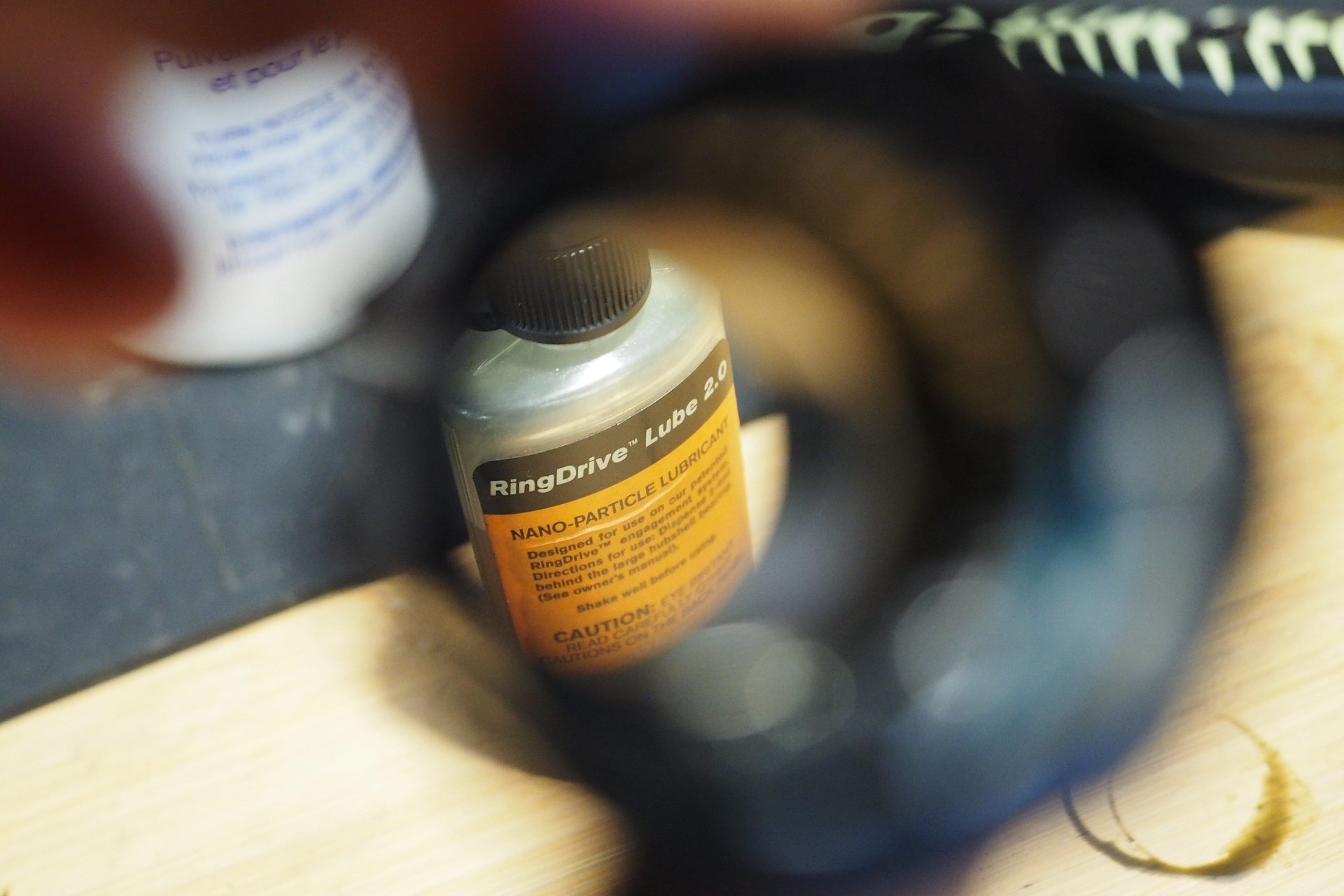
I was never a fan of original RingDrive Lube (RDL) and tried many other products, with my best results being Royal Purple 0W and Dumonde Tech Freehub Lube. I've been using the RDL 2.0 for a couple years now and I highly recommend it.
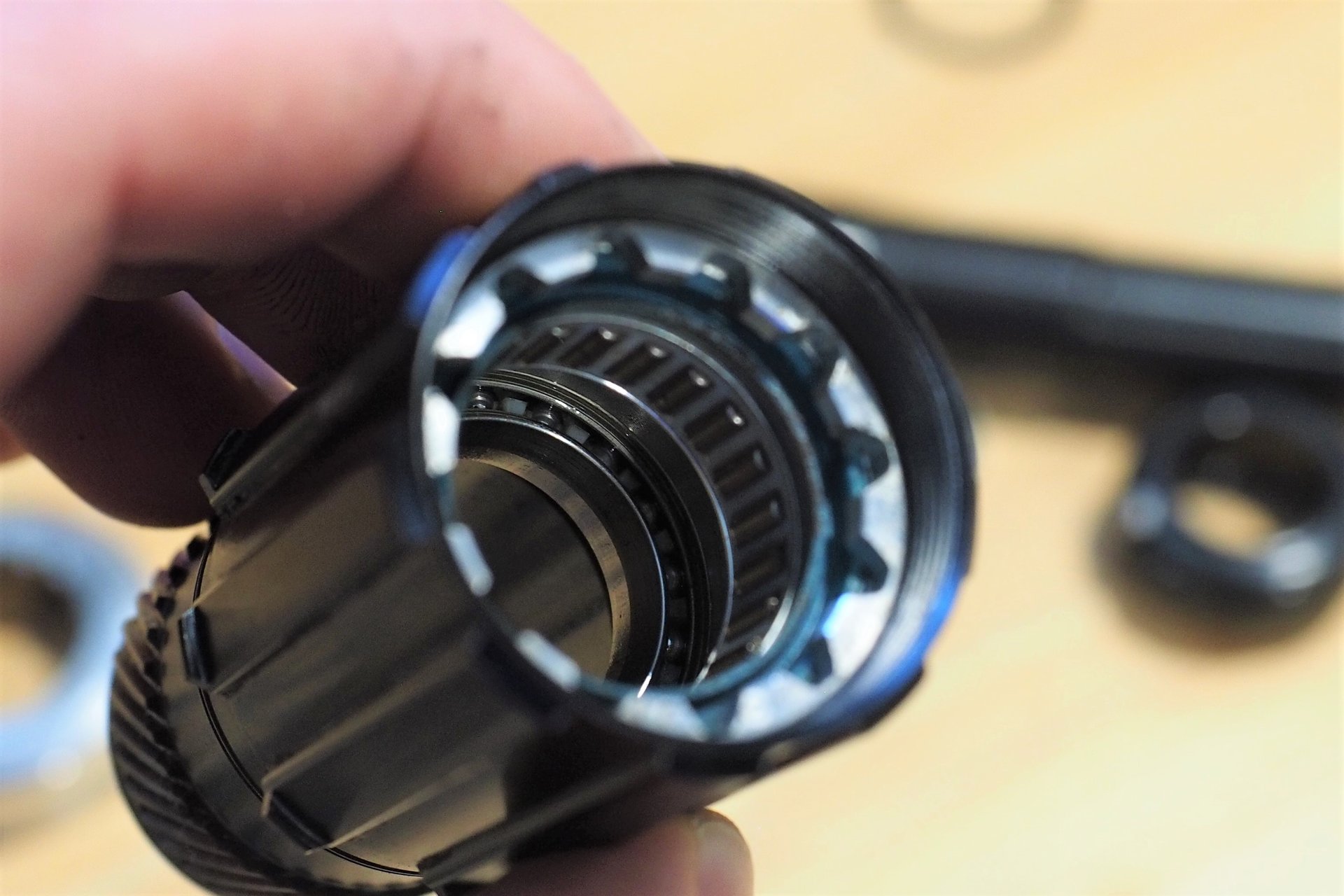
Clean freehub body post-service. Kings are the only hubs I've used that feel better - faster and smoother - over time.
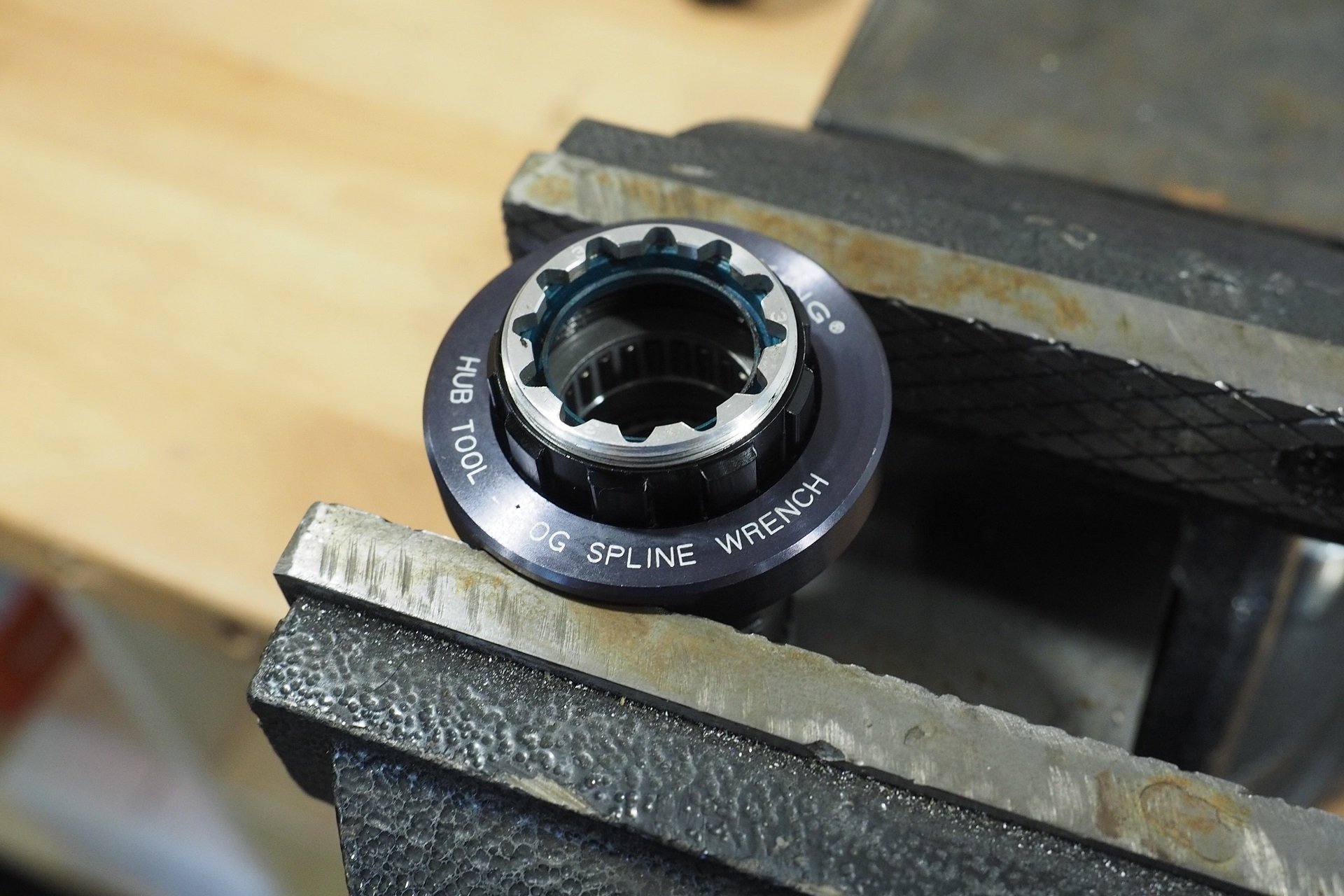
Putting the freehub body back together, the right tool - in this case the Chris King hub tool - makes it easy.
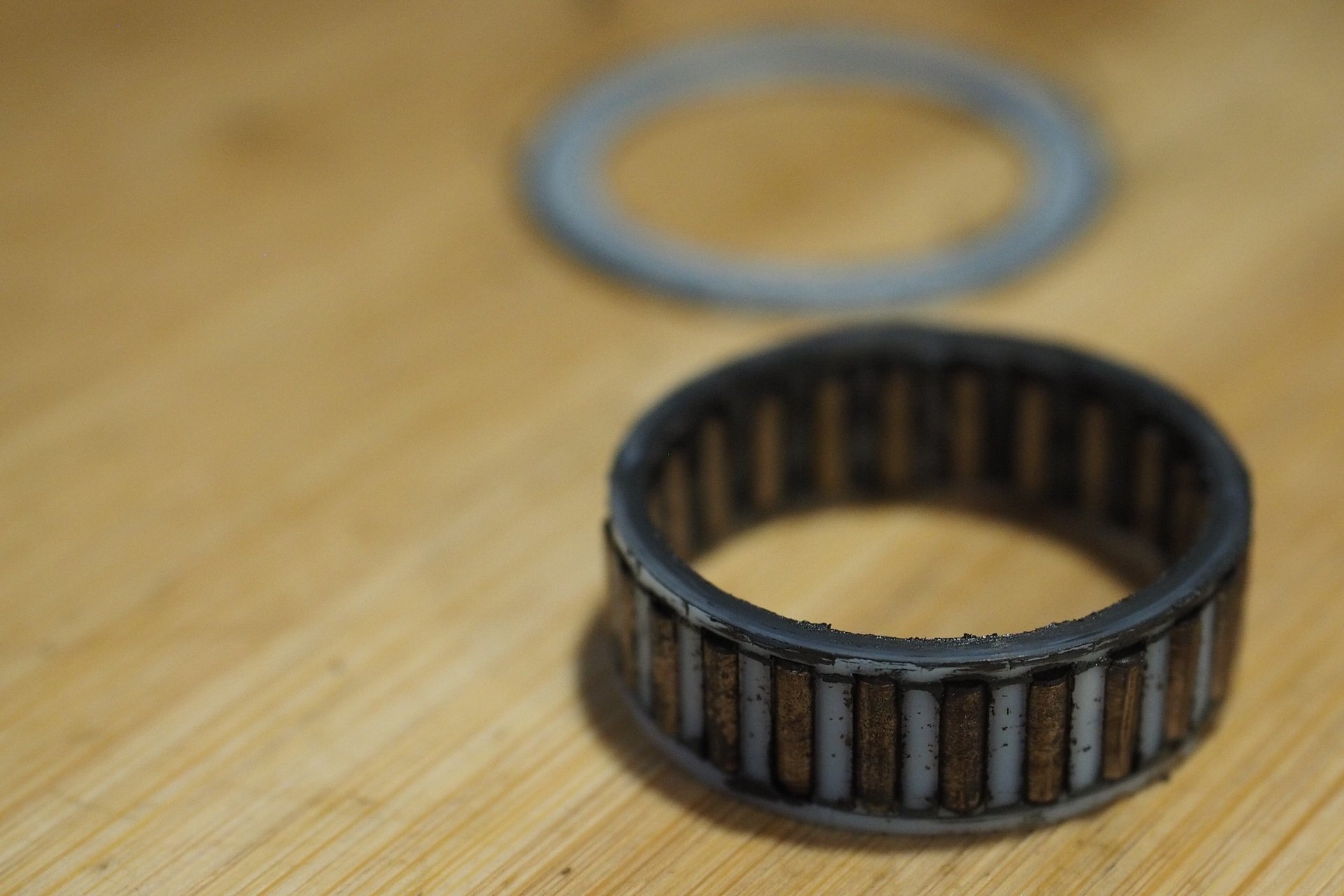
The needle bearing pre-cleaning. The way this beauty supports the axle is one of the keys to how long the other bearings last.
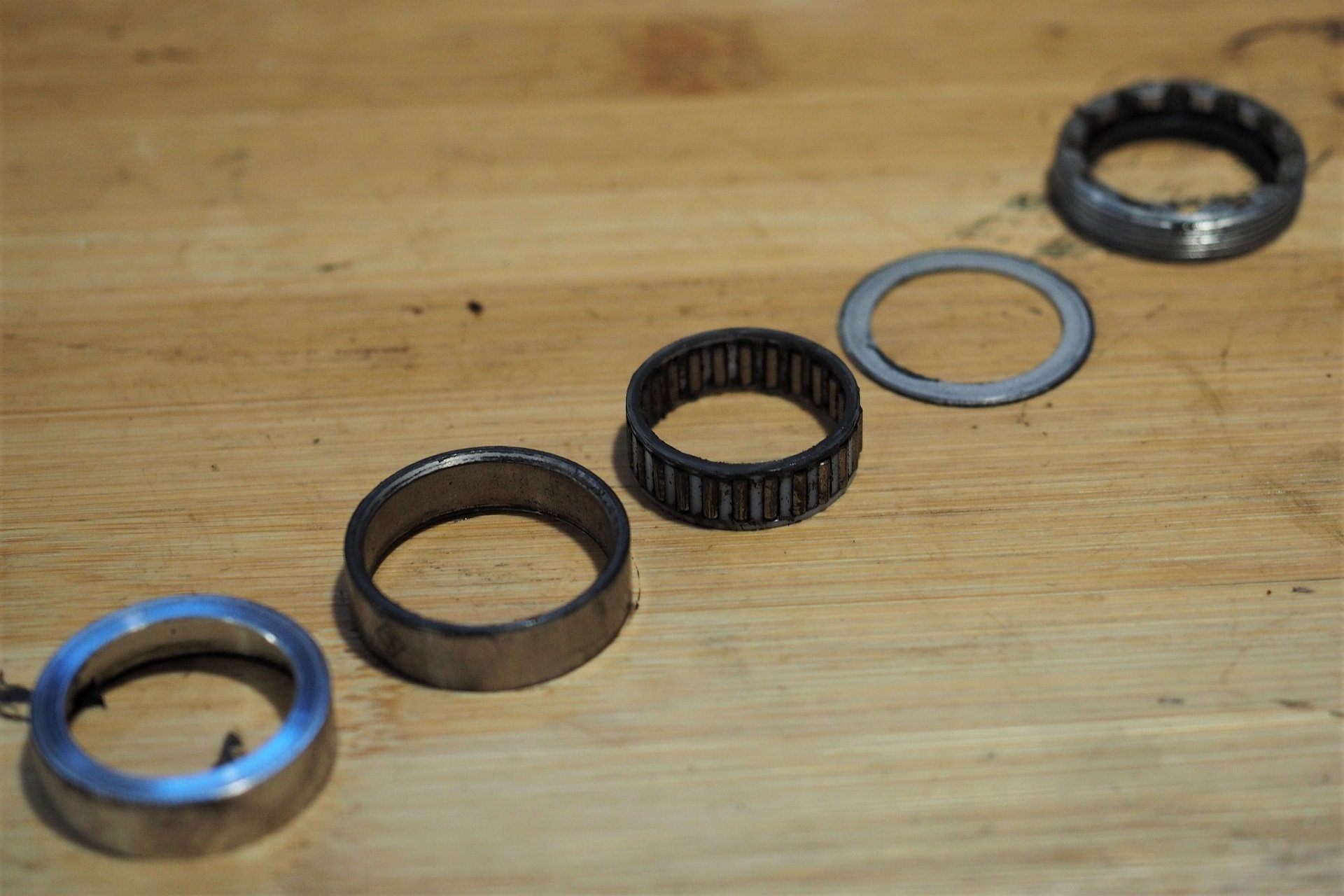
A couple of times now I've seen Chris King hubs that had been 'fully serviced' but the freehub body was not disassembled in the process. Maybe a little spray-and-lube works fine but it's a premium service on a premium product, so I think the best practice is to strip down, clean, and lube everything.
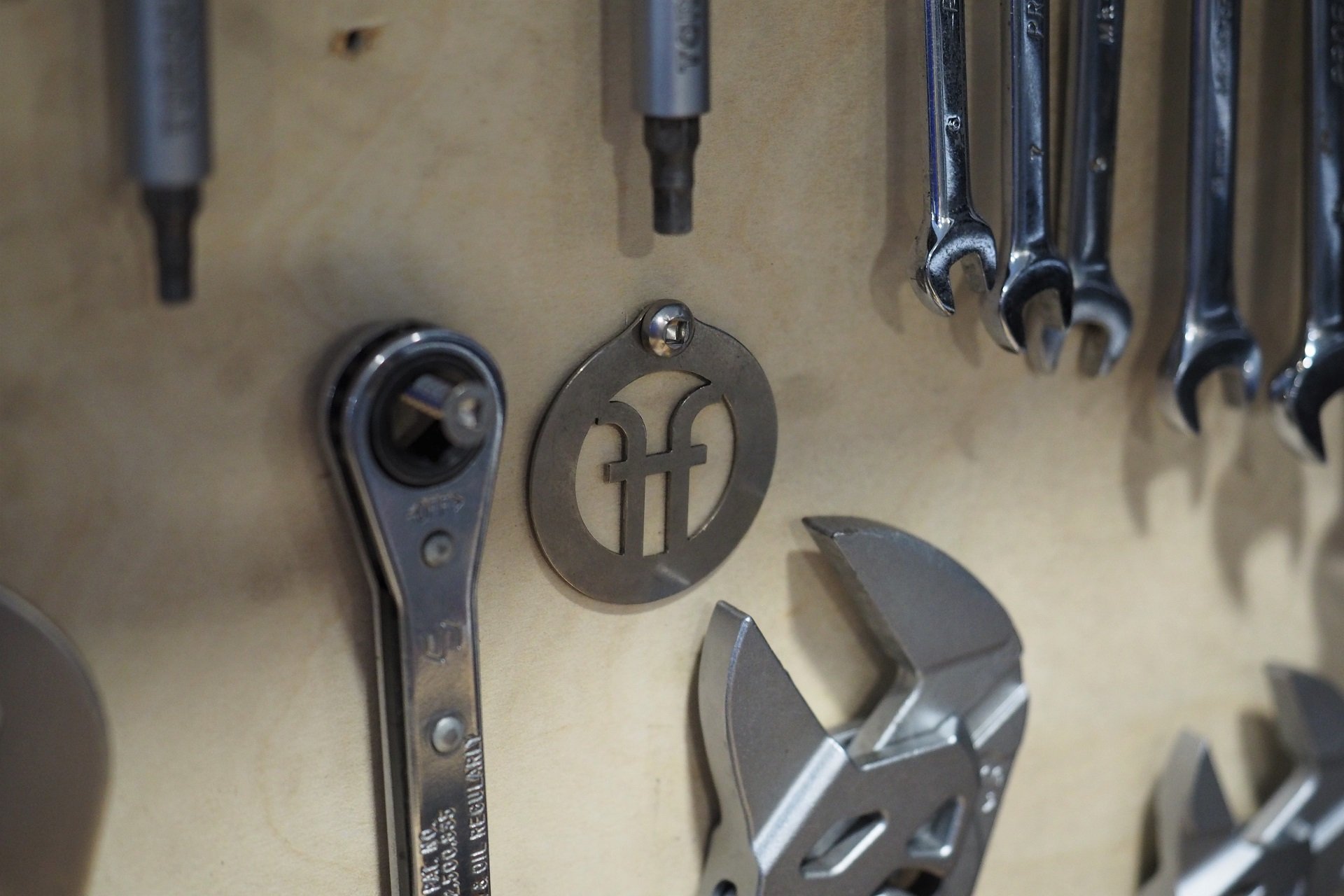
Nice Guy Geoff and I have some shared shop history, and matching titanium ornaments.
I think one important take away from a Chris King hub teardown is that there's no half-way service solution for the aspiring home mechanic. If you know you're someone that is going to pay to have your hub serviced then there's a strong value argument for Chris King. Your shop will probably charge you more labour than say, overhauling an Industry Nine Hydra, but when I factor in the cost of replacement bearings the life time service costs on the Chris King, paying a good mechanic, are still going to be lower. Most shops that sell premium mountain bikes will either have a Chris King tool or have access to one.
On the other hand, if you do like working on your own stuff the Chris King hub does have a higher barrier to entry in the form of buying a tool, which CK sells for 188 USD. It's one thing if you have multiple friends or family members running them, but compared to other hubs, again the Hydra as an example, that is an additional cost of ownership. The King hubs also take a bit more time to tear down, clean, and rebuild but with their excellent instructions, the purpose built tool, a cardboard box, a good plastic hammer, and some patience it really isn't as intimidating a job as some folks would lead you to believe.
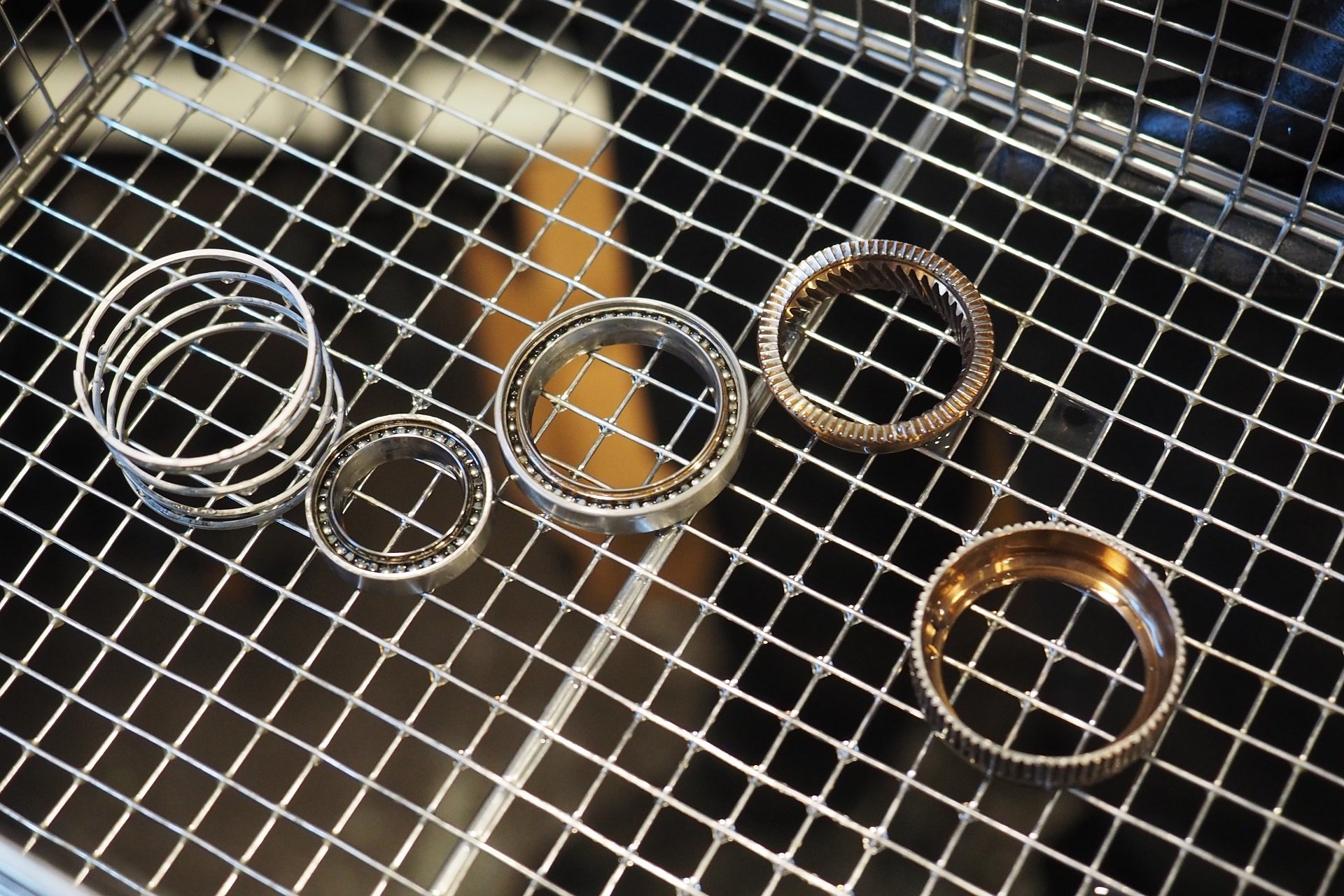
Clean, so clean. You can get here with a tooth brush and some time. Geoff has an ultrasonic cleaner.
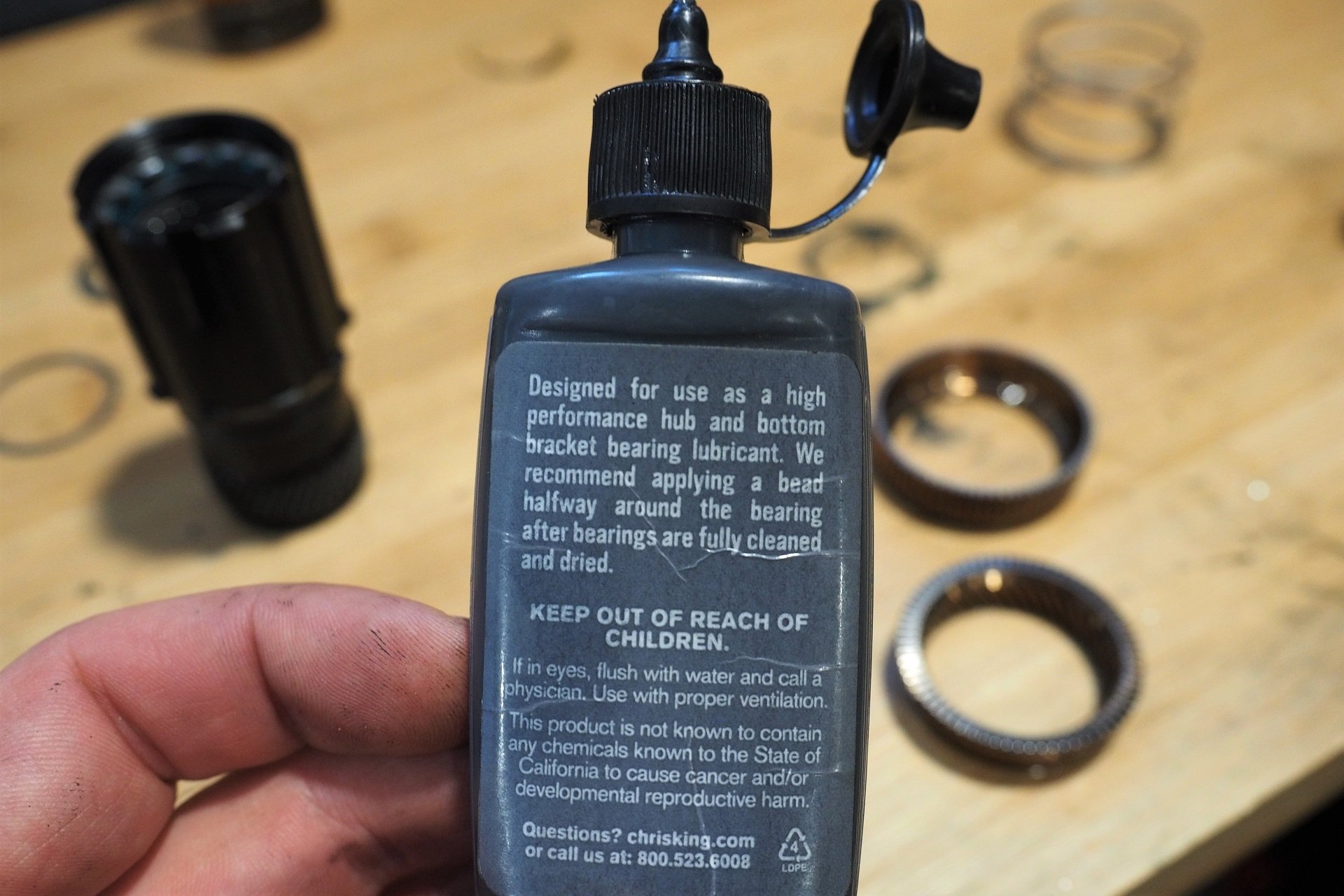
The application instructions are clear, but just in case they have a 1-800 number for lubrication support.
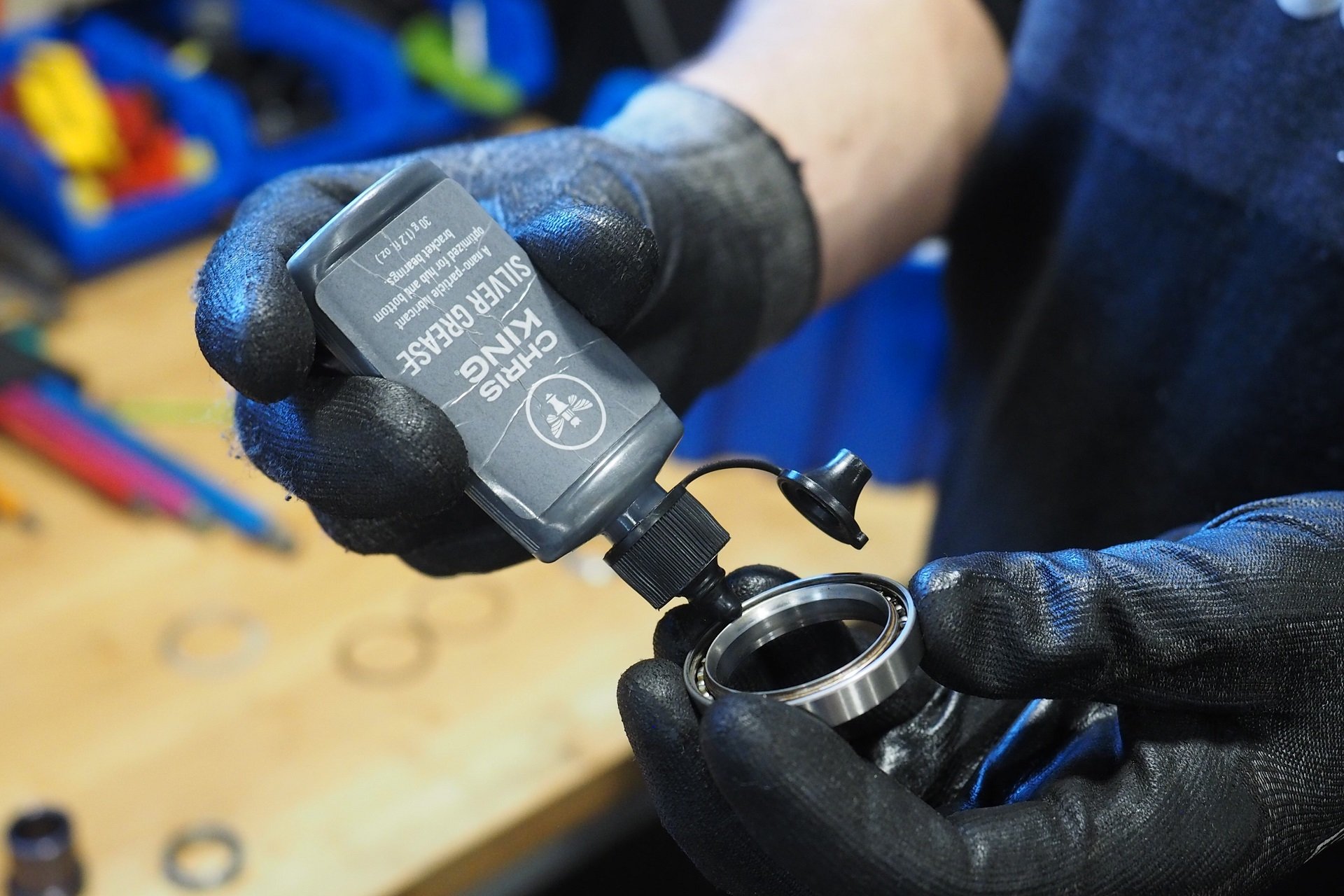
Lasts long, spins fast. Any waterproof bearing grease will do, but with only a tiny amount required, I can justify the cost of using a premium product here.
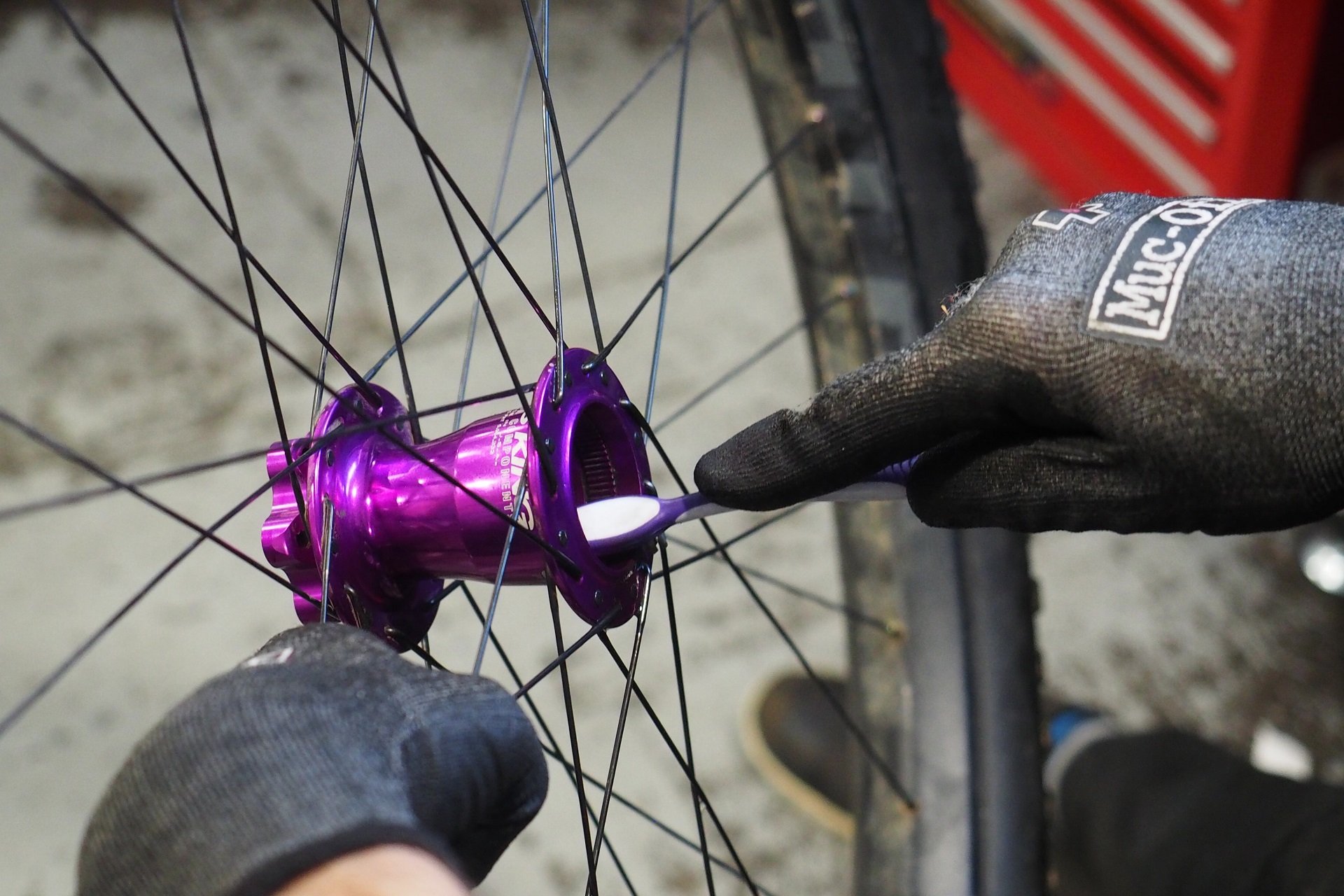
Doing the full scrub-a-dub.
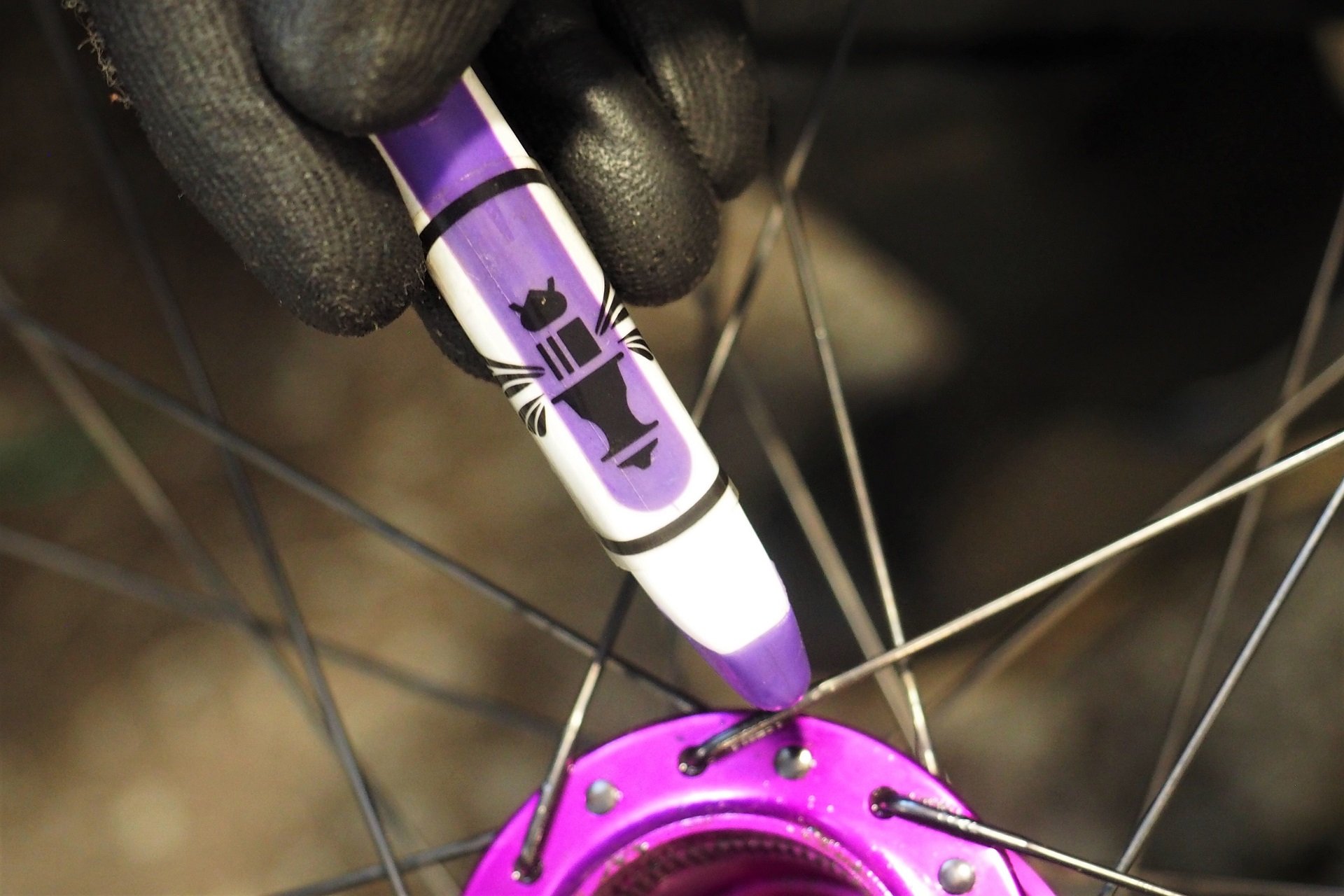
Of course, you should always use the right tool for the job. Like this special edition Chris... no, just kidding it's just a tooth brush. An important addition to any toolbox.
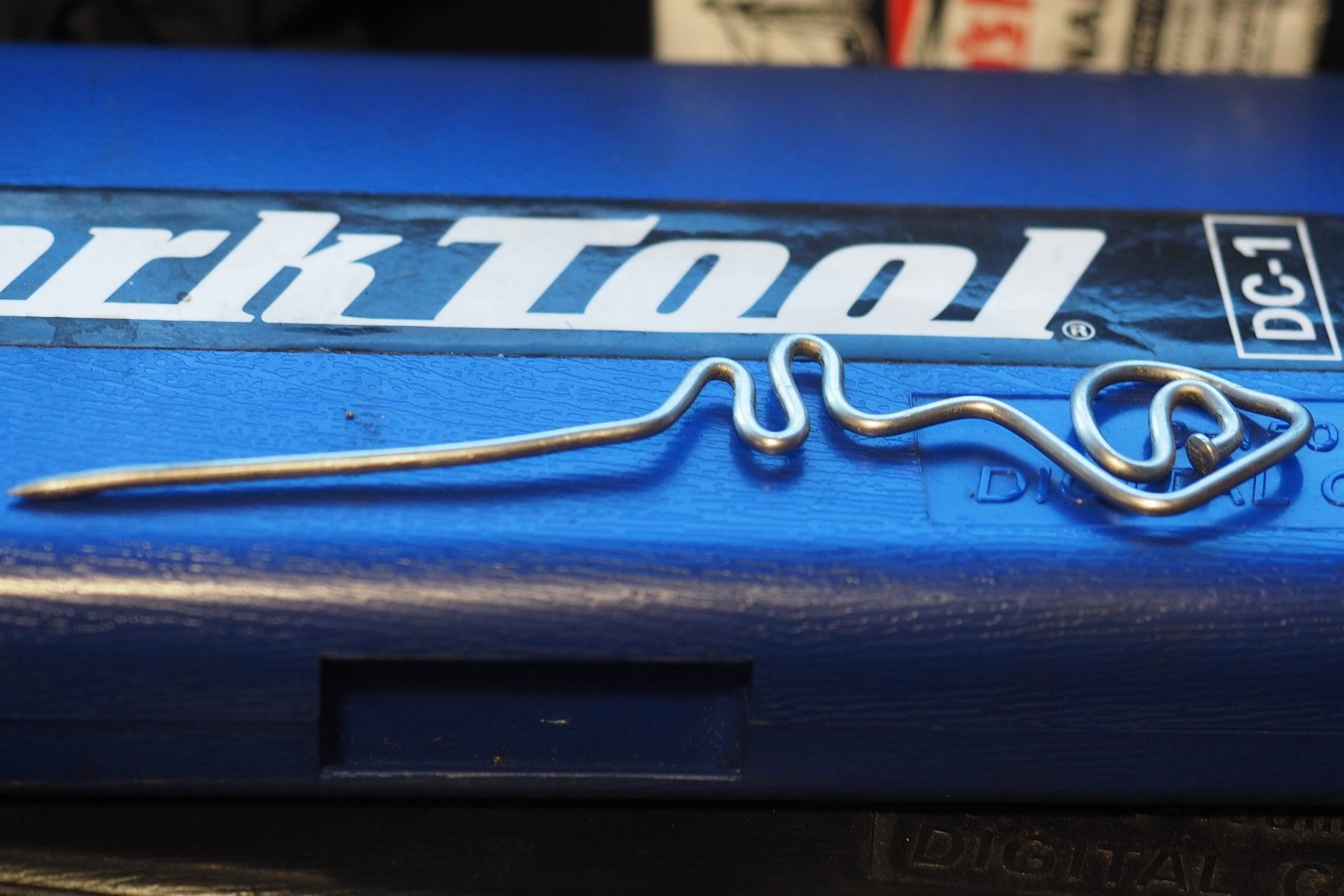
Bike shop randoms: If you're going to make pokey-things out of spokes they might as well be crazy?
Engagement
With the amount of hours on this hub, most of them standing and grinding up climbs with a single speed setup, many of them in the damp conditions of our lower-trail 'offseason,' I have nothing but praise for the condition of this King hub. I also pulled the seals and snap rings of the front hub bearings - without removing them from the hub shell - and both hubs are now spinning better than new. Those 'angry bees' in the back were sounding a little muted & muddled but everything is fresh now for when I'm healed up and back on my bike. I can't wait.
So they're beautifully made, high quality, resilient, and wonderful to service - if you have access to the right tool - and that leaves performance. Chris King hubs, using their classic drive system, have a maximum of 5° of rotation between engagement points. Having ridden a couple examples of hubs with instantly engaging clutches and the might-as-well-call-it-instant Hydra with its 0.52° of float, it's clear I love quick engaging hubs for that feeling of direct input into the drive system whether I'm technical climbing or putting whatever trials skills I have to use. It would be easy to extrapolate that the more instant the engagement the more I would like the product.
While the difference between an instant True Precision hub, a 0.52° Hydra, and a 1.66° Project 321 hub is academic on the trail, I can notice the jump between those hubs and the 5° King if I put my mind to it. But the Chris King is close enough to instant that I never wish for a faster engaging hub. If Chris King moved all their hubs to their lighter R45 guts, which have 45 points of engagement instead of the 72 points of the classic, I would choose a different product in order to have quicker than 8° engagement, but I could ride this 5° system for life and be happy.
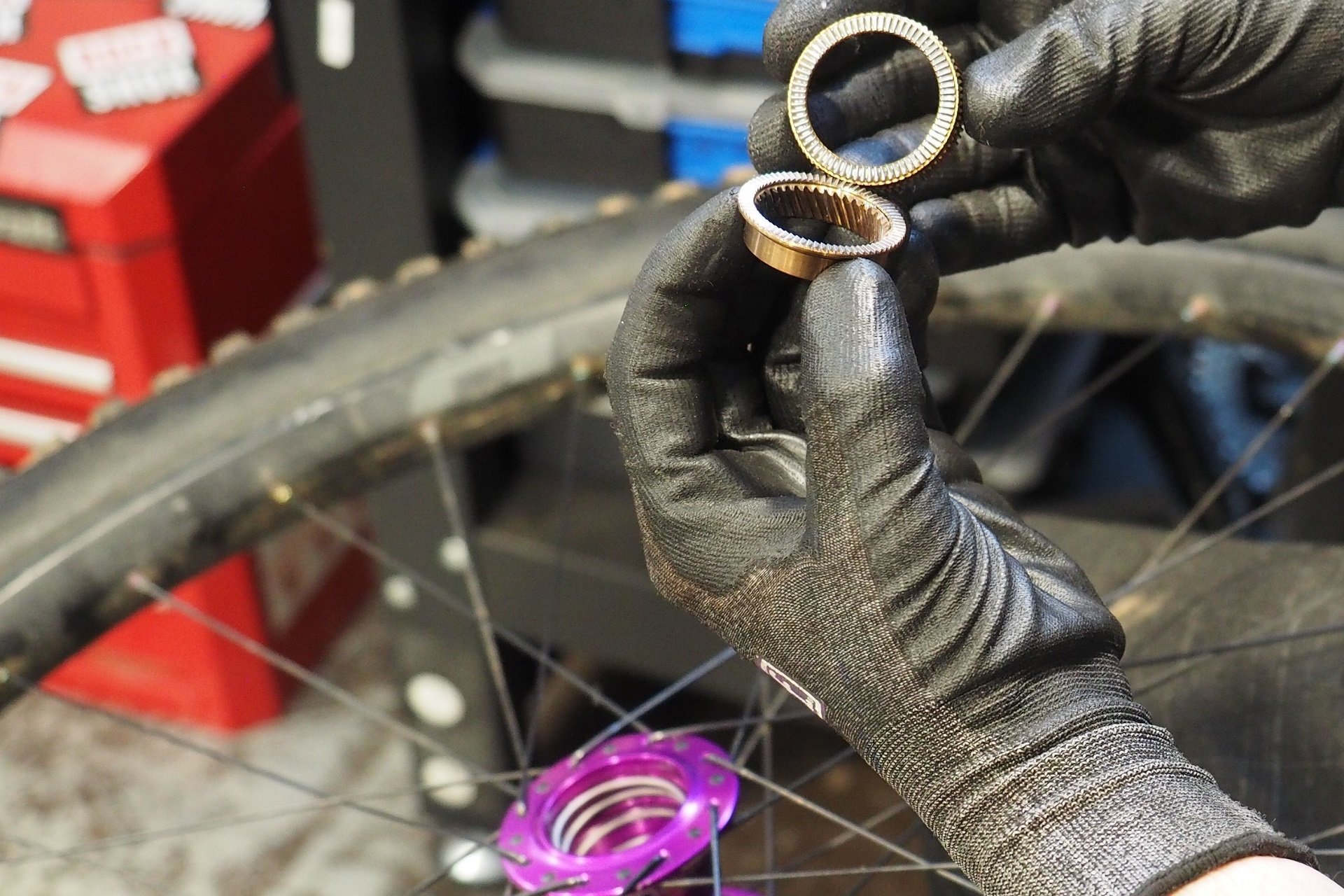
Heat-treated stainless steel drive and driven rings. 72 points of engagement make for a maximum of 5° of float between engagement points.
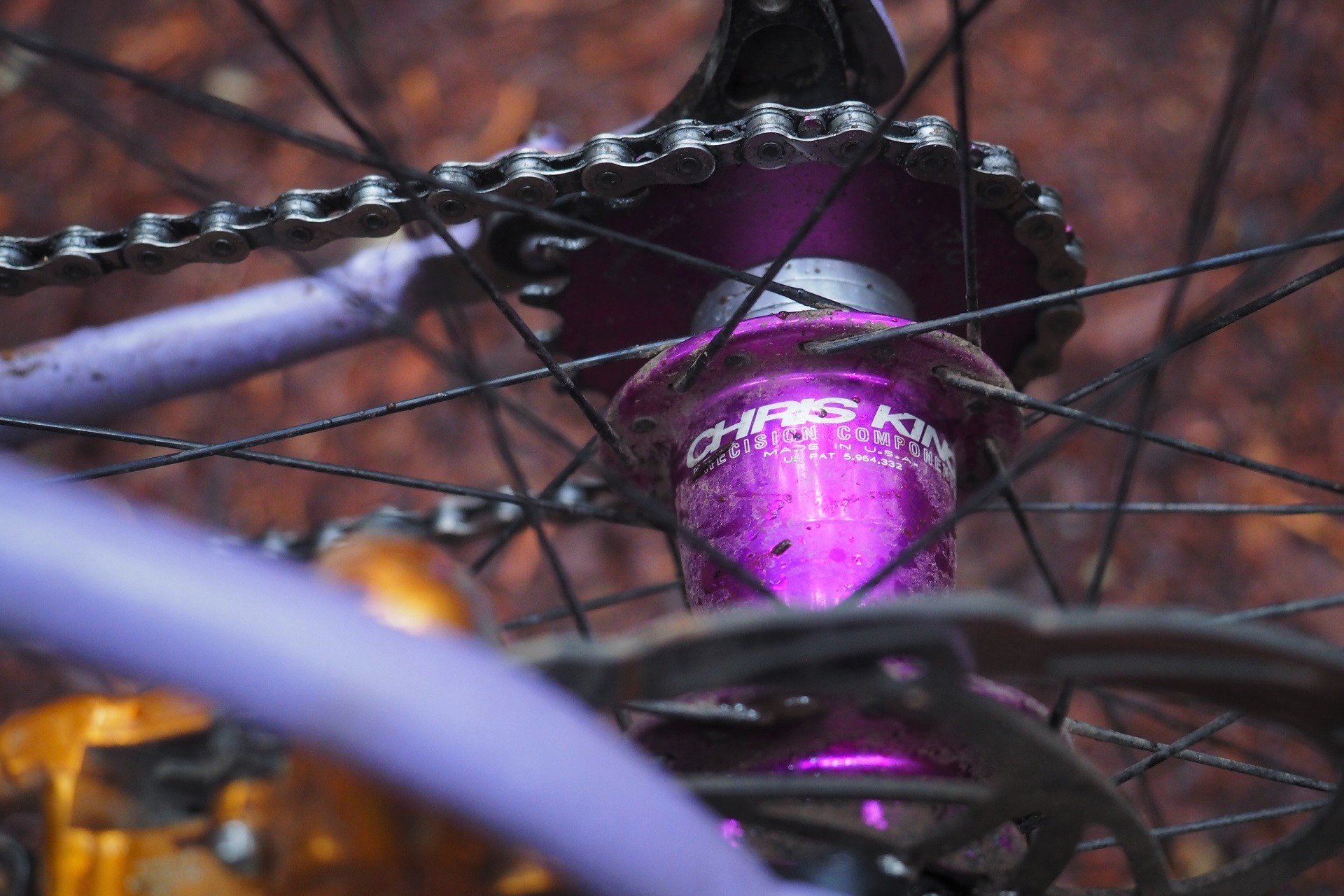
I can't wait to get back on the trail with my hyper-smooth hubs. The degradation of performance happens so slowly I don't notice in the moment but when they're fresh, oo de lally!
Hub engagement falls under the category of personal preference. Some riders don't care even after comparing hubs with 0° and 20° of float back to back on the same bike, on the same technical trails. At one time, Chris King were the fastest engaging hubs you could buy, aside from Shimano's short-lived LX Silent Clutch, and they now fall into a category that anyone could be happy with, even folks like me who are persnickety about instant power transfer. In my mind, a purchasing decision is going to come down to two factors - notwithstanding whether you care about how your rotor attaches.
The first factor is up front cost. A King rear hub is 534 USD | 680 CAD. That's a lot of money especially if you're planning to flip complete bikes semi-regularly. But, an Onyx Classic (the good one) is going to run you 485 USD | 618 CAD and an Industry Nine Hydra is 460 USD | 586 CAD which I would say are both in the same premium ball park, and neither has the long-term value benefit of Chris King's house-made bearings. As Industry Nine's US-Made 1/1 hubs, with 4° engagement, take the higher-end OE market by storm, at 306 USD | 390 CAD for a rear, there are going to be many opinions on how to chop the high-value hub potato.
If I was buying a new set of hubs tomorrow with the plans to run them on my Waltworks for the rest of time, and I could buy the same hubset I've been on for the last couple years, I'd have no issue investing the upfront cost. Keeping in mind, I already own a service tool and I am as confident servicing them as other products. A decade down the line I wouldn't remember the initial price difference and most likely I'd be ahead on my investment by not having to buy bearings. However your own personal math lines up - upfront cost versus maintenance versus long term amortization - I'd guess we can all agrees that these are a beautiful example of fully serviceable form and function.
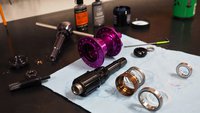
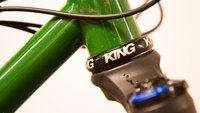
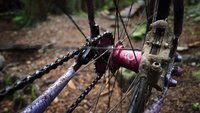
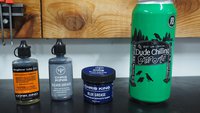







Comments
fartymarty
2 years, 2 months ago
Andrew - I know CK are amazing and all but £500 (insert emoji for jaw dropping and smashing hole through concrete floor) I can get 2 and a bit £200 Hope Pro 4s for the same price. Sure they aren't as good but parts are easy to come by (over this side of the pond) and they work relatively well. Plus Hope do a stainless steel free hubs and 6 bolt rotors.... I would need some serious convincing to upgrade to CKs.
Edit - Hopes are obnoxiously noisy tho...
Reply
Andrew Major
2 years, 2 months ago
I think, if anything, I spent too much time in this piece discussing comparative ways to measure long term and short term value. So, “I can buy X for Y” comments are just going to have me pointing up^^^. Particularly to the last two paragraphs for the TL;DR crowd (which I know you’re not a member of).
There’s a couple of reasons, based on my experiences, you don’t ever see me listing Hope hubs in the various comparables I add to any piece on hubs/wheels. The biggest one is that garage hunk of plastic sitting between the hubshell and freehub body that they call a seal. As with their brakes, they look fantastic and a first glance screams premium but it doesn’t take long before a rider realizes there are much better options for less money.
I9 1/1 eats Hopes lunch. And even something like a Spank will match it for performance and parts support if a rider needs pretty colours. In fact, other than King & Shimano I think everyone still supports 6-Bolt for now. I can’t imagine that Center Lock isn’t the future as much as I’d prefer if it weren’t.
Reply
fartymarty
2 years, 2 months ago
Fair point on the plastic "seal" between the hub and freehub. With Hopes you have to factor in yearly bearing replacement in hub and freehub which you wouldn't with King. I'm still not sure I could part with 500 Queen's heads though.
I have a Hadley I've had for nearly 20 years now that I quite like (quietish and reasonable engagement) - shame its 36 hole, 135mm spacing and needs a new rim (Blunt 36 is the only thing I can find atm)...
Spank sounds interesting tho.
Reply
Andrew Major
2 years, 2 months ago
Hadley hubs are/were great. I know folks who’ve had them a similar length of time with just the odd bearing job. I seem to recall some generations aren’t user friendly for service or bearing spec compared to others but I can’t recall what years/decades those changes happened.
Reply
fartymarty
2 years, 2 months ago
I replaced and axle a few years back and had to buy some tools from Balle Racing. I guess mine is one of the serviceable ones - IIRC I got it in 05 as it came with a Brake Therapy floating brake arm for my Keewee. Maybe one day it will make nits waynonto the Murmur. I think they had Ti free hubs (as ive run cheap Shimano cassettes onnit with very little scoring) but maybe wrong.
Back to Hope tho - for me they do the job and are easy to work and local(ish) therefore tick a lot of boxes.
Reply
fartymarty
2 years, 2 months ago
I replaced and axle a few years back and had to buy some tools from Balle Racing. I guess mine is one of the serviceable ones - IIRC I got it in 05 as it came with a Brake Therapy floating brake arm for my Keewee. Maybe one day it will make nits waynonto the Murmur. I think they had Ti free hubs (as ive run cheap Shimano cassettes onnit with very little scoring) but maybe wrong.
Back to Hope tho - for me they do the job and are easy to work and local(ish) therefore tick a lot of boxes.
Reply
danimaniac
2 years, 2 months ago
hey fartymarty, as you're in europe, even though Brexit happened... there's a bunch of new and interesting Hubs coming from the mainland.
For Example the Erase Hubs (Belgium) are now in 2.0 Stadium which seems pretty good. 60 POE, stainless steel ratchet and titanium freehub, all else is 7075 aluminium. Rear Hub goes for 240 and weighs about 1Eur/g.. you save about 120g to King and still 70g to Hope.
Andrew Major
2 years, 2 months ago
Those Erase hubs look great. Made in Europe, Ti freehub bodies - not much of a weight weenie but very cool all the same.
Heinous
2 years, 2 months ago
There’s something about the way CK are built that just makes them so satisfying to ride and work on. Hadley, i9, Hope, DT all make nice stuff but none of it lasts as well, sounds as beautiful or if you’re in to singlespeed with freehub, takes Fun bolts.
Having said that, I still prefer a screw on Paul Comp hub and WI trials freewheel for SS. Simpler, bullet proof, quieter. I guess if we think about SS with a freewheel, a rear hub becomes just a tube with two bearings?
Reply
Andrew Major
2 years, 2 months ago
I owned a Paul Disc Fhub - bolt-on - that was stolen with my SS Jake The Snake. It was a very clean product.
I’ve know a few single speeders online who swear by Paul + WI (maybe the trials version of the freehub for the faster engagement?). It’s something I’d be eager to try.
Reply
Eric Nelson
2 years, 2 months ago
Hopes are just too loud and my example of one was sloppy from the factory. Would never buy again. But they are cheap.
Reply
Vik Banerjee
2 years, 2 months ago
I run Hope hubs on most of my bikes. Every time I build a new set of wheels I think to myself time to get something better/fancier/etc... then a Hope hub falls to hand easily through a vendor I use and I have another one of their hubs. I rode one freehub into the ground forgetting it needed some love after years of service and beyond that they just keep rolling along happily. I've got two Hopes on SS bikes so perhaps I'll end up with some issues there. So far nothing.
I really should track down a bulk package of bearings to save maintenance $$, but I have to replace bearings sufficiently infrequently that I never quite surpass the motivation threshold for making that happen.
I would like to try a silent rear hub to see if I care enough to move in that direction. My IGHs were pretty much silent and I didn't love or hate that feature. Yet somehow they were enough of a different beast I feel like an experiment with a "normal" MTB would be worthwhile. I hate bells on bikes so my first line of walker defense is coasting so they can hear my hub often that's a nice subtle way to get their attention. Of the noisy hubs I find the Hopes are pretty average in loudness. There are certainly way worse.
I also figure I should try a high POE hub as well. I never think about POE when riding so I assume I'm one of those people that doesn't care about having a really high POE, but perhaps I just don't appreciate the promised land I am missing out on?
Nice tear down. It's sweet to see the internals of bling parts even if I am unlikely to ever own them. #SIXboltFORlifeYo
Some of my Hope hubs started life as 100mm/135mm QR and got converted to 142mm then 110mm/148mm. Unless our SuperBoost Overlords win the day I hope I'll continue to ride the same hubs for another 10 years.
Reply
Briain
2 years, 2 months ago
I actually put a hope rear hub on my partner's commuter for that reason. She couldn't understand why people would get out of my way or not step in front of me when we were out but they would step in front of her near silent Shimano hub. I run a cheap Novatec hub which I thought I'd just use till it died but 10000km later it's still on its original bearings and their smooth. I think a big part to prolonging bearing life is to not powerhose the crap out of these parts while keeping things relativity clean
Reply
Cr4w
2 years, 2 months ago
I've done that same calculus over the years and while the Hopes are kind of the ultimate combination of price:durability:serviceability:light weight, with lots of replacement parts available. I prefer the Hydra 100% on the trail and won't buy any more Hopes.
Reply
Andrew Major
2 years, 2 months ago
Maybe at one time, but other than the lack of colour options I can’t see how the I9 1/1 doesn’t get that crown today.
The new DT 370 with Star Ratchets - again other than lack of finish options - is a contender for the best overall as well for those that care not about quick engagement.
Agree, Hydra is sweet if you can justify the extra investment.
Reply
Vik Banerjee
2 years, 2 months ago
I'll keep the I9 1/1 in mind for next time. The price is close enough to Hopes so my eyes don't bleed. I like a colour hub on the right bike, but black can float around the fleet more easily so it's a great choice as well.
Reply
4Runner1
2 years, 2 months ago
I have been running the I9 1/1 for a few months. Very impressed thus far. They’re louder than my old 350’s, but not in an unpleasant way. Also enjoying the higher POE. We’ll see how durable they are in the long run.
Reply
Andrew Major
2 years, 2 months ago
I truly think they're the gold standard for quality/performance/cost/value on the higher end (without being super Gucci). I've worked on a bunch of them now and their OE spec is legion - We Are One, Crankbrothers, IBIS, etc, etc.
Reply
mrbrett
2 years, 2 months ago
I would agree except for the super loose hub shell bearing fit - green loctite fixed it but I don't think that should be necessary. Everything else about my 1/1 experience has been great - including working with them on the loose bearing issue.
Andrew Major
2 years, 2 months ago
Interesting, I haven't had a Hydra, Torch, or 1/1 where I've had to use a retainer to hold a hubshell bearing in - though generally, the drive side bearings are not a super-tight fit (can be extracted by tapping on the axle).
Good to hear re. customer service experience. I've had nothing but good experiences.
Andy Eunson
2 years, 2 months ago
I didn’t get to ride my We Are One wheels much this fall as the snow came early but to 1/1 hub skips every ride or two. I have a torch hub on my 27.5 wheels which have been pretty much negletable for the past four seasons. I do clean out the freehub pawls but that’s it.
Reply
Carlos Matutes
2 years, 2 months ago
Did you take the free hub apart and check for lube/stickiness? Sounds like there may be too much grease, keeping them from engaging.
Andy Eunson
2 years, 2 months ago
Can’t reply to you directly Carlos, but yeah that’s the first thing I did. Twice. Now that I think of it, I had the same issue with my Torch hub. It really had too much grease, the 1/1 seemed ok.
Carlos Matutes
2 years, 2 months ago
Just wanted to make sure. I never had this issue with 1/1s in the shop, but did have a couple of Torches that had trouble engaging due to overly heavy lube.
nothingfuture
2 years, 2 months ago
This is, as per standard, an excellent teardown article that takes a sober look at the cost/benefit of premium bike parts.
I have a related/tangental question: I'm fascinated by the Onyx Classic hubs and their "instant" engagement (and, I suppose, silent operation), but I've heard that the grab of the rear clutch is "spongy' to some degree- and while instant *sounds* good, spongy does not. I understand that from a practicality standpoint, any small degree of sponginess is likely irrelevant, but the tiny details of operation somehow end up mattering, don't they.
Anyway: any comment on the feel of the three hubs you mention? (I9 Hydra, Onyx Classic, and King)
Reply
Andrew Major
2 years, 2 months ago
Thanks!
I never (never?) take the “test ride; then decide” cop out but I have to here on the Onyx.
Hydra is solid and ~ instant. King or I9 1/1 is solid and quick.
Onyx Classic, I think whole forums are dedicated to whether you’ll feel “wind up” and whether that comes from the hub itself or from other aspects of a chain drivetrain. And whether it’s an issue or a feature. I haven’t owned or tested the Onyx but I’ve ridden them on single speeds and I could certainly picture myself owning one - specifically the classic model.
One thing some riders (not me, generally) may consider is that Hydra is very light, King is not lightweight, and Onyx Classic is heavy. If you’re riding a full suspension bike that’s unsprung mass.
Reply
Gage Wright
2 years, 2 months ago
I've ridden Onyx CLASSIC and VESPER. VESPERS are a time bomb with a short fuse of 10 rides in my experience. CLASSICs will run a lifetime and I chalk it up to deeper bearing placement in the hub shell and better sealing of the driver body with the preload ring on the classics. VESPERS save a few grams but if your 620.00 dollar hub slips, eats bearings and needs to be kept California dry all year then I would tell Onyx to go back to the drawing board and return to the PNW when they have done their homework and product testing.
Will NSMB be testing the Tarin Hubs? Specifically the Mugen? Tear down with a quarter and a bearing press. Silent. Durable from what I hear. There are so many load hubs and as one of the niche riders who love silent but instant engaging and durable hubs I need more options than just Onyx.
Reply
Andrew Major
2 years, 2 months ago
Tarin hubs would be very high on my personal list of something I'd love to test. Lots of very practical thinking going on with their products. Until I have at least some idea of when I'll be able to ride again though it's not something I can pursue in terms of a review.
Reply
LWK
2 years, 2 months ago
I got an Onyx classic rear hub/new wheel last season. My personal experience is I never feel the wind up while actually riding. I have only noticed it while doing track stands in that you can feel the sprags engage as you put pressure on a pedal with the brakes locked. I'd estimate its maybe at most 10mm of crank rotation (couple of degrees?).
Reply
Andrew Major
2 years, 2 months ago
Exactly. That's my experience as well, but it really is a product where everyone's take may differ. It's a lot of money to spend and then decide that engagement feel doesn't work for you.
Reply
Gage Wright
2 years, 2 months ago
Maybe less in my opinion. It is a little "soft" as there is no pauls to click against but the engagement is still instant.
Reply
bushtrucker
2 years, 2 months ago
I recently purchased an Onyx Classic 6-bolt hub, "upgrading" from a DT 350 with the 36pt ratchet in my touring bike. I would say the Onyx definitely feels smoother and I don't notice any wind up or spongeyness before the pedals engage. That being said the hub went onto a bike with a 30,000 km old Rival 1x drivetrain and man can I feel every bit of slop in that now haha.
I like the Onyx enough that I'll probably order one form my hardtail soon and will be keen to see how it goes on that single speed. For reference I have a WI XMR hub (purchased second hand) with an XD driver that I just don't love so hoping the Onyx will be an upgrade from that.
Reply
Gage Wright
2 years, 2 months ago
GET A CLASSIC! I have ridden both and the classic went from fulls suspension bike to hardtail and is just a lovely bit of kit (circa 2018-current). The Vespers slipped and then blew up after 10 rides.
600+ dollar hub, 60 dollars+ in bearings, three re-services, 15 rides total and 3 months not biking = vespers are excrement.
Reply
Eric Nelson
2 years, 2 months ago
Went from Kings to Onyx class in for geared and SS use in technical terrain and would not go back. The Onyx are simply amazing. And solid. Any wind up felt is in the frame or other parts of the drivetrain.
Reply
Kachew
2 years, 2 months ago
Has anyone noticed that CK seems to have done away with the needle bearing in the hub shell? As you mentioned - I always though the use of the needle bearing was pretty critical to their amazing lifespan, but a look at their Boost Centerlock hub diagram has no mention of a needle bearing. I can’t recall seeing any needle bearings in service videos either.
I think those hubs have been out for a while now, and there don’t seem to be any reports of premature failure, or anyone questioning the decision either. It seems like a change that’s slipped under the radar? Maybe it just doesn’t make that much of a difference? Or maybe all of the ‘real’ cyclists have just been buying the last batches of 6-Bolt hubs that still use the needle bearings? Or is the increased spacing just easier on bearings?
Reply
Andrew Major
2 years, 2 months ago
I have to admit I haven't rebuilt the new generation (as of 2021) of hubs and my understanding was that these beauties were still current. I guess, in fact, my opening paragraphs are that much more relevant now. From the current (2021) specification drawings the needle bearings are indeed gone. I updated the body of the article (with attribution to you for pointing it out - thank you).
I can't imagine - based on my experiences with many other hubs - that the large driveshell bearings will last as long now as they have previously (i.e. forever). Maybe they still last long enough? Certainly, for me, it's another reason that I'd be keen to watch the used market for 6-bolts.
Thanks!
Reply
Allen Lloyd
2 years, 2 months ago
My Mango colored pre-boost CK hubs will stay with me till I die. They have been on 3 different bikes and to me they offer the perfect feeling for a hub. The fact that they could be used for generations only adds to the joy they bring.
I spent 4 years saving for mine and am now at the point where I will probably buy another boost set some time soon for my full suspension bike. My only issue is with the color, I also have a mango headset and the color difference is crazy. I think at some point they changed the color and I unfortunately landed with non-matching stuff.
Reply
Andrew Major
2 years, 2 months ago
I have a mango hubset, where the shells weren’t from the same batch, that are very different colours as well and though they seem to have sorted it in the last few years, colour matching was a complaint with King hubs for a while.
My understanding is this was the result of moving anodizing in house and trying to use more sustainable practices but I couldn’t find anything to back that up in writing and it’s been many years since I was told that.
The purple headset on my bike is from the first time they offered it as a limited edition colour (it’s been in a few bikes) and the hubs are very different but I think in this case they weren’t meant to be the same finish - rather two different unique LTD runs of purple.
Reply
Allen Lloyd
2 years, 2 months ago
Yep, my headset looks like it has faded over about a million years compared to hubs. BUT more importantly to me is that all the stuff works better today than when I bought it over a dozen years ago.
Reply
papa44
2 years, 2 months ago
My 20 year old Chris kings are probably going to live out the rest of their days (I.e. forever) on my wife’s chromag after a change from qr three piece to bolt through. I changed frame to something a touch more contemporary and thus boost, so thought I’d get some cheaper hope pro 4s, which I found had too short lived a bearing life in uk conditions, so ended up getting a another set of kings to replace them. Couple of years flawless service already and I have no regrets. The only reason I don’t also run a king headset is because i keep changing frames looking for the perfect hardtail and it would bankrupt me keeping up with the never ending standards, same goes for bottom brackets to be fair. I would say that bb’s along with headsets and brakes are where hope have pretty good value for the grunt they provide. If you’re in the uk anyway.
Reply
Andrew Major
2 years, 2 months ago
As the 73mm BSA Bottom Bracket reclaims its throne as the defacto standard for mountain biking and least it will come down to two standards - 24mm Axle or 30mm Axle (reducers for DUB). I know plenty of riders who wouldn't consider a bike that didn't use a threaded BB for their next purchase and I think the momentum is certainly going that way.
Headsets is a tough one indeed. Endless standards, and also some well-made alternative options in pretty colours - like Wolf Tooth, White Industries, Hope. I'm certainly nostalgic for the days of the EC34/EC34 (1-1/8") headtube and being able to move a headset from frame to frame for all time.
Reply
Karl Fitzpatrick
2 years, 2 months ago
I can't just let you get away with the morepork caption!
Here in New Zealand, the Maori word for Morepork is Ruru which, I think, is actually more phonetically accurate and way more fun to say if you're confident with rolling your Rs.
On my local trails, Ruru are often heard and sometimes seen on night rides which is always pretty bloody special.
Also, I'm a Hope guy.
Nice article though thanks! 👌
Reply
Andrew Major
2 years, 2 months ago
Hahaha. Thanks! I’m so stoked that folks clicked through and noticed/commented on the random shop additions! I added a note to the photo caption.
Reply
Velocipedestrian
2 years, 2 months ago
If you want to hear the Rūrū (original indigenous name, we have a litany of daft colonial names for everything) then Clicky Clicky.
Reply
Andrew Major
2 years, 2 months ago
Thank you!
Reply
Andrew Major
2 years, 2 months ago
So, that sure sounds a lot like "More Pork" to me. Either way, I updated the photo caption so folks can decide for themselves! Thanks for the sound link and the info.
Reply
Velocipedestrian
2 years, 2 months ago
Oh I can see how the Morepork name happened, it's more a complaint that it stuck around over the existing name. I'm sure there are plenty of similar situations in Canada.
Reply
Andrew Major
2 years, 2 months ago
Tons. Actually, my daughter has learned quite a few place names and words in the local language Hunq’eme’nem.
Reply
Reuben.Sandwich
2 years, 2 months ago
In my experience,
I bought a "flogged out" dh hub off a privateer member of the Australian DH team a few years back for a project bike. Stripped it down and found the spring that engages the ring drive was comparatively looser than my other hubs (3 full UCI seasons will do that) but otherwise with some new grease it was as new.
Reply
Andrew Major
2 years, 2 months ago
I have some friends who’ve bought some ROACHED King hubs and been able to get them running new-as. I’d say they’re a stand-alone component in that regard. Most roached stuff is simple roached.
It’s such a small world. Who doesn’t own a Crombie tool v. how many mechanics have a tool named after them!?!
Reply
materials-guy
2 years, 2 months ago
Having purchased my first King hubs back in 98 I believe, they are still going strong.
I do own the service tool but have only used it twice. For the servicing of the rear hub all I use is mechanics degreaser to clean the bearings, free hub and ring drive (after taking out the seals) then blowing out all the parts with compressed air.
I have never had an issue doing it this way, I also use Phil Woods tenacious oil for the ring drive which makes it almost silent. This I prefer over a noisy hub.
Reply
Andrew Major
2 years, 2 months ago
I’d prefer to see everything (pull it apart) and to individually service/grease the bearings, but you’re not the only person I’ve talked to who has had good results with this method. There’s also absolutely a canyon between best practices when you’re billing a customer in a shop and what works perfectly for a rider wrenching at home.
Out of curiosity, do you live somewhere wet (like our Vancouver rainforest) or somewhere drier? I’ve talked to riders in places that never see wet rides who claim whole decades on Kings with nothing but a minor drivering lube.
It gets cold enough here in the winter than many oils gum up the works and keep the RingDrive from engaging. I haven’t used Phil, glad it works for you! Just want to reiterate for anyone reading that RingDrive Lube 2.0 or Mobil-1 are King’s recommendations. Seen a few folks try something else and then needing to rebuild again.
Cheers!
Reply
materials-guy
2 years, 2 months ago
Hey Andrew
My former nick name was The Krazy Karpenter. Yes I live in a rain forest.
Living in Coquitlam I have had many issues in the early days. The old King ring drive grease would all but freeze in cold temps where your free hub would "free wheel" and leave you stranded in the middle of know where. Talked with a King rep 20 ish years ago and asked if Phil's oil would be ok, the answer was yes, been using it ever since.
Had the added benefit of making the hub almost silent.
Reply
Andrew Major
2 years, 2 months ago
Thanks! There are so many different climates and sports surfaces it’s really helpful for context. Very interesting. I tried a lot of options instead of RDL 1.0 but never Phil Tenacious.
Cheers,
Reply
mrbrett
2 years, 2 months ago
Years ago, I had some polished Kings on a bike for several seasons with a perfect reliability record. In hindsight I regret selling them to "upgrade" to a Boost size bike and I have another set of 6-bolt polished King hubs on my buy-now list when I see a low mileage set come up used.
Reply
Andrew Major
2 years, 2 months ago
It’s too bad (in addition to dropping 6-Bolt) that King didn’t make a nice Boostinator kit of their own. I’ve heard a similar lamentation to yours too many times now.
In my extended friend group there are (actually) a lot of 100/15 and 142/12 King hubs being run with Problem Solvers’ simple Boostinator spacer kit to work with Boost 148/110. Not as perfectly clean a solution as a King-specific axle would have been but certainly a great way to carry forward a lifetime purchase.
Reply
AverageAdventurer
2 years, 2 months ago
I love my fun bolt 135 king on my dj, it's over a decade old at this point and won't die. It's outlasted a pro4 on my hardtail and I can't get enough of the noise. I recently picked up the aforementioned black and gold hubs much to my disappointment about CL. The hubs for life appeals to me I just hope standards don't change too much in the coming years.
Reply
Andrew Major
2 years, 2 months ago
Fun Bolts are a product that deserves their own nerdy article. Fun fact, they were originally called that because they were NOT fun to make - one bolt at a time.
I (stupidly) sold my last set a few years ago because all my bikes were thru-axle but now I wish I had them for my wife’s 135x10 commuter instead of the QR adapters.
The black & gold looks so premium! I don’t think we’ll see a new rotor standard, I just think CL is going to ~ kill off 6-Bolt even on budget rigs. Which isn’t, for the record, suggesting there will ever be a problem buying 6-bolt rotors.
Reply
AverageAdventurer
2 years, 2 months ago
I seem to remember some tales of old about the new guy getting the "privelege" of making them. It's arguably one of my favorite pieces of kit. If you can make a full nerdy article about them i'd read it.
Bummer about selling yours, i can't stand to part with 90% of my parts bin for fear I may need it later.
I guess i wouldn't mean a new rotor standard, but through a desire to run the matching hayes rotors for the dominions an adapter seems to be the only way, i also don't love the subtle rock front to back on CL. I can't imagine it gets any better on a budget rig.
Reply
LWK
2 years, 2 months ago
I dont have the fun bolts but I am glad to hear that at least one other person has King hubs on their DJ bike! I have an old set of pink CK hubs - started out 135, switched to 142 axle and then moved over to my Trek Ticket DJ build a few years ago. They have to be close to 15y old now.
Reply
Andrew Major
2 years, 2 months ago
That's so sweet right? 15-year old hubs that are still as sweet as anything on the market. Think about what other 15-year old products you can say that about. Also no reason to think you won't still be riding them 15-years from now.
Reply
bushtrucker
2 years, 2 months ago
Great review. Always been curious about King but the fact that I like working on my own hubs and don't wanna buy a $300 (AUD) tool has always kept me from investing. Also, by the time I could actually afford one they stopped making the 6-bolt version. So yeah, this —
"It's sad for me, as I greatly prefer 6-Bolt and can't see myself ever investing my own money in a CL hub, and, therefore, never buying another King hub myself."
Anyway, I ended up getting an Onyx classic 6-bolt hub and so far so good. Would love if you could get ya hands on one of these for a review Andrew! Tons of colour options and they look like a dream to work on too.
https://onyxrp.com/store/bike-hub-service/onyx-iso-mtb-hub-assembly-and-disassembly-video/
Oh and as far as pre-load goes nothing can be worse that WI disc hubs. Trying to hold that pre-load collar down while angling a 2mm hex into the grub screws behind the rotor is just painful.
Reply
Andrew Major
2 years, 2 months ago
I like the Onyx Classic hub though my experience is service related and second hand - not something I’ve tested / ridden extensively. I learned last week that they actually make a Boost148mm single speed specific hub (don’t know of another company that does!). When I can pedal again I’ll definitely make contact to see if they’re interested.
Reply
Heinous
2 years, 2 months ago
Paul Comp do Boost SS
Reply
Andrew Major
2 years, 2 months ago
Cheers, yes I was just looking at their hub options. To be honest, the Paul / WI freewheel combo hasn't been on my radar for ages until you mentioned it today.
Reply
Heinous
2 years, 2 months ago
I’ve found them to be flawless. I’ve a set here that’s 12 years old and only needed two pairs of bearing on that time despite a thrashing. The other is a little newer but seems just as good.
Reply
Andrew Collins
2 years, 2 months ago
I'm probably the absolute worst use case for hubs: 150kgs, 6'3" and I like to winch and plummet at a low cadence.
I've owned lots of hub brands and unfortunately only had one experience with CKs which was negative (noisy under power). They were fixed under warranty but I lost faith and sold them.
My current min/max champions are the Funn Fantoms from AliExpress. They share bulletproof internals with the Spank Hex and Nukeproof Horizon V2 so spares are cheap and plentiful. The bearings are high end Taiwanese ones and are miles better than the rubbish ones in Hopes.
IMO every brand has its foibles so it's really about choosing what you will tolerate.
P321s sometimes lose magnets from the pawls that get munched in the mechanism.
I9 pawls can skip disconcertingly under power. The freehubs can warp and the drivering can get chewed out but are replaceable.
DT 54t star ratchets are for weight weenies only and sometimes the driverings get really stuck, which makes changing bearings impossible.
Hope bearings are rubbish. The inboard freehub bearing will almost certainly disintegrate first and cause the pawls to lockup. This can be solved with good Japanese bearings.
Novatech axles are weak and can often break.
Don't get me started on Mavic or the old Eastons.
Reply
Andrew Major
2 years, 2 months ago
Did King say what they fixed/changed re. noisy under power? Usually differences in RingDrive noise come down to lubrication. Just curious, as I've never come across a King hub warranty issue.
Was it the one-piece HD axle (preload collar with the set screw) or an older three-piece axle unit? I've read some bigger dudes saying the axle upgrade made a world of difference (added stiffness) but that change happened a long, long time ago.
Cheers,
Reply
Andrew Collins
2 years, 2 months ago
It was about 10+ years ago and it was a bearing seat being out of spec. Apparently CK had a tooling issue with a batch of hubs and this was one of them.
It was a one piece axle unit, and I made sure the preload was right.
I've got a set of Hope Pro2 Evos where the bearing seat on the steel freehub has expanded. I need retaining compound for the bearing but otherwise it works as per normal. I think the ratchet mechanism on the CKs has finer tolerances and just wouldn't tolerate a slightly loose bearing and complained under load.
Note: I've cracked Hope alloy freehubs and Shimano XT cassette spiders.
Reply
Andrew Major
2 years, 2 months ago
Interesting! I've seen bad batches of products make it out of even the most diligent companies' factories. There's always that second measurement point - how they look after the issue - so it sounds like you had a very honest experience at least? I wonder how many made it into the world and riders didn't even notice.
Reply
Andrew Collins
2 years, 2 months ago
Funnily enough there was huge flame war at MTBR over that batch of hubs. Glad I don't share a land border with those guys.
Yep no problem with the warranty experience.
Reply
Andrew Major
2 years, 2 months ago
Yeah, the whole “Team Brand-X” thing is a bit aggressive over there. Thought I was going to have to go into the tester relocation program after my (very positive) Banshee Titan review went live.
Brian Tuulos
2 years, 2 months ago
how many degrees between engagement points on this Funn fantoms? Dont see it on their spec sheet
Reply
Andrew Collins
2 years, 2 months ago
102poe so 3.5°
Reply
Andrew Collins
2 years, 2 months ago
This comment has been removed.
Peabobryson
2 years, 2 months ago
Miss you
Reply
Andrew Major
2 years, 2 months ago
Back at you!
Reply
cheapondirt
2 years, 2 months ago
It's a compliment to your writing that this was fairly predictable yet still interesting.
I just bought an entry-level complete wheel on Saturday after contemplating saving up for a nice rear hub. Since in the end I wanted a different diameter more than high engagement or other things that come along with a high end product, I couldn't make the numbers make sense for me. Whole wheel for the price of a rim and lace... Blow it up, just buy a new one... I wince at the mentality but admit it's the only way for the cashflow-restricted.
Reply
Andrew Major
2 years, 2 months ago
Cheers!
I both totally understand and wince at the mentality. Unfortunately with hubs longevity can be tied to price if you want something to last a long-long time. I know it's more of an initial investment, but I have to think that - in addition to a better on-trail experience - there's a min-max level that gets you something rebuildable for a lower overall cost of ownership.
If you don't care much for high engagement, these Chromag hubs are bomber (and the steel axle makes space for bigger bearings). Not that they're cheap at 300 CAD, but like King, they're a reliable used purchase even if they haven't been well cared for by their original owner.
I've also seen a lot of folks have good luck with Spank hubs (though, as I noted, if there was ever a company that could use a re-branding). The Hex hubs have an e~ version - which is just a ridiculous way of saying they have a steel freehub option - but for folks trying to maximum product life that could be a good choice. They come in plenty of colours too and have a 3.5° engagement. They run ~320 CAD for a rear.
Reply
cheapondirt
2 years, 2 months ago
Spank products in general strike me (ha) as pretty solid, yet why buy them - particularly the components with bigger logos - when so many alternatives exist?
Thanks for the tip on those two hubs and I'll keep them in mind for next time.
Reply
FlipSide
2 years, 2 months ago
Thank you for this article! It was a great read.
I'd be interested to see how you rate the RaceFace Vaults compared to the other products named so far in the discussion in terms of Min-Maxing potential.
I have 2 sets and they have been very good to me so far. It seems to me they certainly do not belong in the Premium category (like CK, Hydra, etc.), but I find the numbers of POE, overall design and pricepoint makes them an interesting choice for somebody looking for a good quality and high-engagement hub without going to CK and I9 Hydra prices.
I'd love to hear your thought on this. :)
Reply
Andrew Major
2 years, 2 months ago
I like the layout of the Vault a lot. While I've seen some drive ring failures (though didn't experience any issues myself testing the hubs) the fact that it's attached to the freehub body makes it very easy for anyone to replace v. drive ring failures where the drive ring threads into the hub shell.
I think they could do a better job of shielding the bearings (and spec'ing better bearings) and the hub is in an interesting price category (like the Spank Hex) where it's not as much money as a boutique North American made option or cheap-and-cheerful like a basic Formula TW.
I've heard rumours of an updated version and I would certainly have both hands up to test one as I think the concept of the layout (pawls in the hubshell) is excellent.
Reply
Brad Sedola
2 years, 2 months ago
I've been on the fence with using my old ISO hubset on my gravel bike. Rear is 135/9mm qr and needs to be switched to 142/12mm. Doesn't seem they are available through CK anymore. Any pointers on where to track one down? I am in BC, so it would be nice if we kept things in Canada. Might be too much to ask these days.
Reply
Andrew Major
2 years, 2 months ago
Is it the one piece axle that you currently have (with the preload collar that has a 2.5mm hex key set screw)? Or the older 3-piece setup that needs a Preload tool?
If it’s the former, you need an axle PHB569 or PHB569B. If it’s the later you need that and a collar PHB708.
Apparently these parts are not in stock anywhere at the moment, but I can’t imagine King not supporting all the 135/142 hubs on the market going forward. For an ETA I would try your local shop, AVT.Bike (Aspire Velo Tech), or King directly.
If it was me, in the meantime, assuming you have the 1-piece axle, I’d get a machine shop to drill out the axle to 12mm, put a 3.5mm spacer (12mm ID) on either side, and ride it. Basically it’s a Boostinator kit but you don’t have to re-space the rotor.
Reply
Andrew Major
2 years, 2 months ago
It sounds like these will be back in stock sometime in Spring (2022). I’d definitely pre-order.
Cheers,
Reply
Brad Sedola
2 years, 2 months ago
Great question. It's an older hubset, but I believe it is the 3 piece jobber as I recall. They are currently laced up on my old Maverick Durance hanging in my storage unit. Figured I may as well get some use out of them. I'll attempt to preorder for sure. Thanks Andrew.
Reply
Brian Tuulos
2 years, 2 months ago
Never understood the centrelock hate. Does it not work for you? What's your gripe - or just Tribalism? I'd argue that a centrelock rotor is superior. Stiffer, less prone to bending, better heat dissipation, and available in ice teck or regular steel. I have both 6 bolt and centrelock on my bikes, and they both work just fine. Rotors are cheap and wear items.
Reply
mrbrett
2 years, 2 months ago
I've had play issues in the CL splines, that seemed impossible to cure permanently.
Reply
Brian Tuulos
2 years, 2 months ago
yes, if you rock your bike back n forth the play is there. Does it affect your riding?
Reply
Andrew Major
2 years, 2 months ago
Center Lock is in exactly the same category of product as Trunnion Mount. On paper, there are positives from a design and implementation perspective, and if you've never had or seen issues with the product - and particularly if you own the product and have never had issues - then it may not make sense why others are down on it.
If you're interested I covered the concept - as it relates to Trunnion - in the introduction of the last piece I wrote that NSMB.com published: All Things Being Unequal.
As regards my opinion on Center Lock specifically, no it isn't Tribalism. I genuinely believe that 6-Bolt is a superior standard for rotor mounting. I've been working in shops since before CL came out, and I've encountered plenty of issues with the standard since. If I had to choose one thing I don't like about it, it's the fact that when rotors come loose they wear the hub interface - yes, I've seen hubs that require replacement or new hubshells. That's not the rotor interface - as you note they're a wear item - but the hub interface which means even a new rotor will have a sloppy fit (assuming the fit was tight initially).
I know, every single person who ever comments on the superiority of CL rotors always checks they're tight before a ride and has never had one come loose on the trail so wear - and not being able to tighten them trailside - isn't a concern for them. But I'll say again, loose CL rotors are a regular reality when doing bolt checks in a shop. With 6-bolt there's no hub interface to damage and a loose rotor can easily be tightened with a T-25.
On the CL pros side, I don't see how they'd be less prone to bending compared to an equivalent 6-bolt rotor (say comparing two Shimano composite aluminum/steel rotors) but I choose to run 1-piece steel rotors anyways as they're much nicer to straighten/true. In fact, other than the cleaner appearance I don't buy any advantage other than they're faster to remove and install.
Anyway, it's good that you like Center Lock as it is certainly going to become the dominant rotor-mounting standard. If you're at all interested, I wrote something (albeit, a bit ranty) about that too.
Cheers,
Reply
Heinous
2 years, 2 months ago
For Gravel and road bikes (so still running 100mm spacing) the CL does significantly improve wheel geometry and strength for fronts.
Having said that, I’ve not seen well built not CL fronts fail, but the people who have had a front fail tend to be vocal (even with their jaws wired shut).
Reply
Andrew Major
2 years, 2 months ago
Really? On average how many mm is the non-drive flange moved outboard? I never would have guessed that was a thing given how few 100x15 wheel issues I’ve seen in MTB, even with super light rims. Guess spoke count is a big factor.
I have seen some gravel bikes running suspiciously lightweight and low spoke count wheels being used on gravel bikes, for what is essentially trail riding and I would have guessed that to be more of an issue that flange width.
It’s high time for g-road to go Boost 110/148 anyway isn’t it?! With12mm front axles of course.
Reply
Heinous
2 years, 2 months ago
I agree on the overly light gravel wheel front. I used 32 CK’s on Stan’s and HED rims, but was given a pair of i9 gravel wheels, 24 spoke, by the distributor. I was super sceptical but they took at absolute hammering on mtb trails. Sadly they were stolen with my Moots.
I’mnot a big PVD fan, but his maths is good. Check this post for the 6BvCL. Summarised below:
The 110×12 CL wheel is 12% stronger pushing to the right and 14% stronger pushing to the left compared to the 100×12 CL wheel
http://www.peterverdone.com/100x12-should-never-have-existed/
Reply
Andrew Major
2 years, 2 months ago
24 spoke with I9 aluminum spokes or with the steel spokes? I can see that working great with their spokes.
Why not just go with 110x15? I never understood the 12mm front axle.
Heinous
2 years, 2 months ago
@Andrew - should we all have gone 110x20m years ago? I suspect 12mm was close enough to existing road standards that they could just remove axle and bearings. It does look a little more elegant and I've not seen 12mm axles fail or flex.
Andrew Major
2 years, 2 months ago
I guess in my mind, mountain bikes - all mountain bikes - should have stayed as 110x20mm and then road 100x12 or 110x12 or whatever would have made sense.
But, axle sizes being what they were, going from QR to thru-axles, given that they were adopting the 142x12 standard for the rear anyway, wouldn't it have made perfect sense for road thru-axles to be 100x15?
I'm sure you're right. It was probably easy to make existing hubs/wheels and forks work with 12mm.
Brian Tuulos
2 years, 2 months ago
The aluminum centre carrier of a CL rotor (I just measured mine) is 8-9mm thick in section. Compare that to typical 1.7mm thick steel sheetmetal 6 bolt rotor.... the CL carrier is way stronger and stiffer (less prone to bending)
As for loose centre lock nuts, ya I can see how the aluminum splines would get ruined. Never happend to me of course. Agree in that case not as robust as 6bolt. Hey, its the numbskulls that keep the economy trickling along, good for business lol.
Reply
Andrew McKee
2 years, 2 months ago
Andrew, just curious what gives you the indication that CL will become more or less the prevailing standard moving forward? I agree with your assessment of the relative pros and cons of the two interfaces, and also prefer 6-bolt for my own bikes. Maybe you are reading a different set of tea leaves than myself, but I have my doubts that a decade-old Shimano standard is going to make a run after treading water for so long. Anecdotally I haven't seen a change in the distribution of the two standards in the shop lately. If it's a gravel/road bike thing, that's simply none of my business, but I think 6-bolt deserves its place for MTB.
Reply
Andrew Major
2 years, 2 months ago
Two-decade-old standard!
As I understand it the patent expired in August. While there have been limited non-Shimano Center Lock rotor options (Magura, SRAM) for years now, I'd expect an uptick in the availability of basic replacement rotor options as well as budget CL hub options - where non-Shimano Center Lock hubs have been higher-end to date - DT Swiss, Industry Nine, Chris King, etc.
I'm seeing Center Lock coming in from two directions. One, Shimano has been massively pushing their wheel program the last two years, and common now for low-to-mid level mountain bikes with Shimano builds to have Center Lock mounting. Kona is an example I throw around. Rocky Mountain too.
It's true that there's a huge exception of bike companies doing their wheel programs. I know that cuts out a lot of bikes - Giant, Trek, Specialized - but let's see what they're doing in two years.
Then look at after-market wheel brands. DT Swiss still does 6-Bolt for OE customers (the Canyon Lux Trail I tested for example) but try buying a non-Center Lock wheel from them aftermarket. Santa Cruz / Reserve is Center Lock. Reynolds is Center Lock. Enve is Center Lock. King is Center Lock. Ibis is an interesting one where their cheaper wheels are 6-Bolt but the top-end options are Center Lock, which would indicate to me where they're going.
I also don't think that, like Presta valves, we can discount the influence of high-end road bikes on mountain biking. It's not as simple as ignoring that many companies that make 6-Bolt hubs/wheels for MTB are only making CL now for Road/Gravel. Bontrager is an example, Specialized/Roval have Center Lock road wheels too, as does SRAM/Zipp.
Industry Nine still offers most of their mountain wheels in both Center Lock and 6-Bolt, so they're the canary that I'm watching. As with all this stuff, it will be fun to come back in 3, 5, 10(?) years and see where we're at. I very much prefer 6-Bolt as well and if I was king of mountain biking it wouldn't be going anywhere.
Reply
Andrew Major
2 years, 2 months ago
This comment has been removed.
Briain
2 years, 2 months ago
My last bike that had CL I had it work loose on two different rides which was then end of my day because I didn't carry the tool where as I've never lost a bolt from a 6 bolt set up and even if I did I could get by on 5 or replace it trail side
Reply
bushtrucker
2 years, 2 months ago
This comment has been removed.
YDiv
2 years, 2 months ago
Curious to know, why do they use an unsealed driveshell (aka freehub) bearing? Not referring to the needle bearing, but the one that's just past it. Is it just for less drag?
Wondering if you might have any insight @Andrew, or anyone else really.
Reply
DBone57
2 years, 2 months ago
I will never own another 6 bolt hub in my life. I just don't see how some of you screw up CL..... cassettes must put the fear of god in you! lol
Reply
Please log in to leave a comment.